Story and Photos by ITN European Reporter Herve’ Rebollo. Photos by Samar.
Salut à toi American rider,
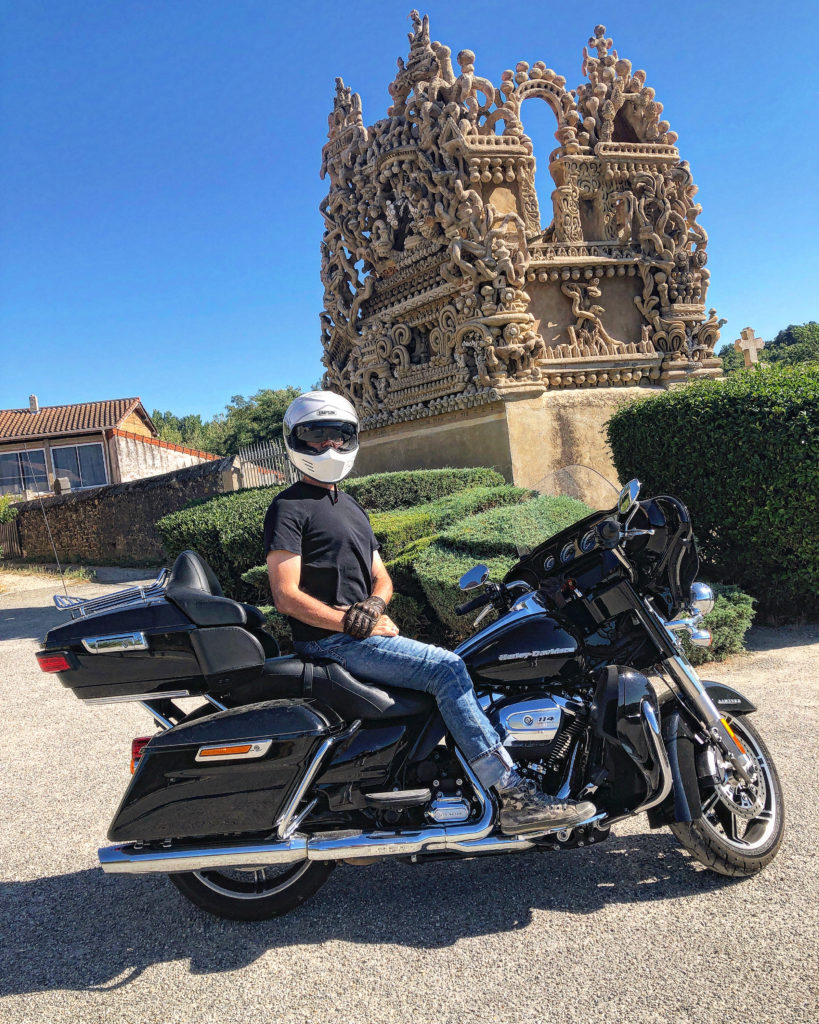 This summer my dealership, as I’m still waiting for the delivery of my (less n’ less) brand new FLH for one year now, was fair enough to lent me an Electra …cool, no???
This summer my dealership, as I’m still waiting for the delivery of my (less n’ less) brand new FLH for one year now, was fair enough to lent me an Electra …cool, no???
This is why my blond and I have been able to spend about two weeks on French roads. It gave us the opportunity to make a road-trip we wanted to do for a long time : the ride to the IDEAL PALACE OF THE POSTMAN CHEVAL …
 But, you can imagine that we took our time to reach our destination, and under a sun of fire, we crossed France at a cool slow rhythm, taking our time to meet old friends, have great food and wine to celebrate our French lifestyle …
But, you can imagine that we took our time to reach our destination, and under a sun of fire, we crossed France at a cool slow rhythm, taking our time to meet old friends, have great food and wine to celebrate our French lifestyle …
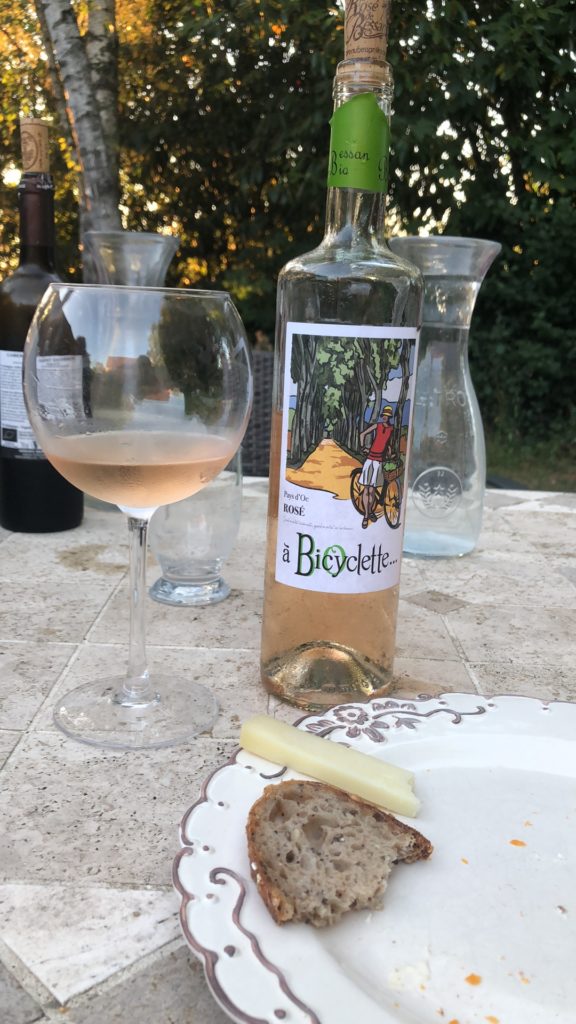 Roads where really cool and we have seen and crossed so many nice places …
Roads where really cool and we have seen and crossed so many nice places …
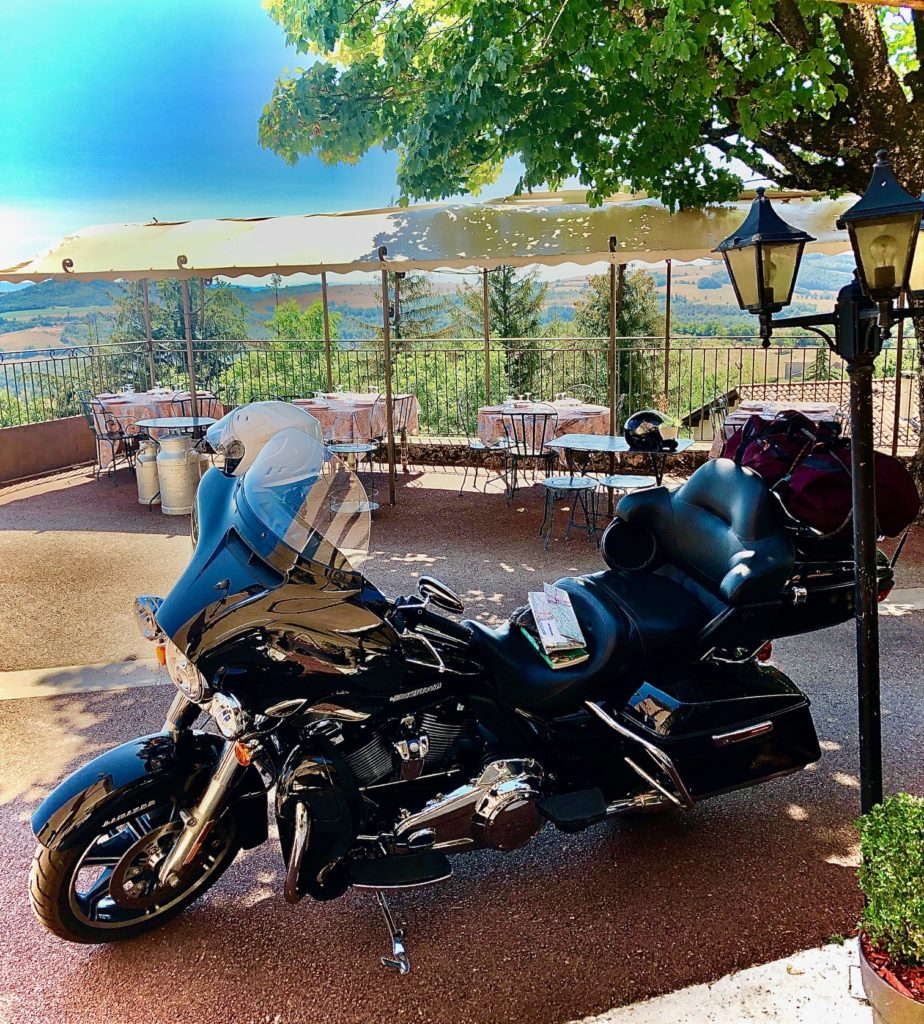 And of course, no reason to use any GPS …
And of course, no reason to use any GPS …
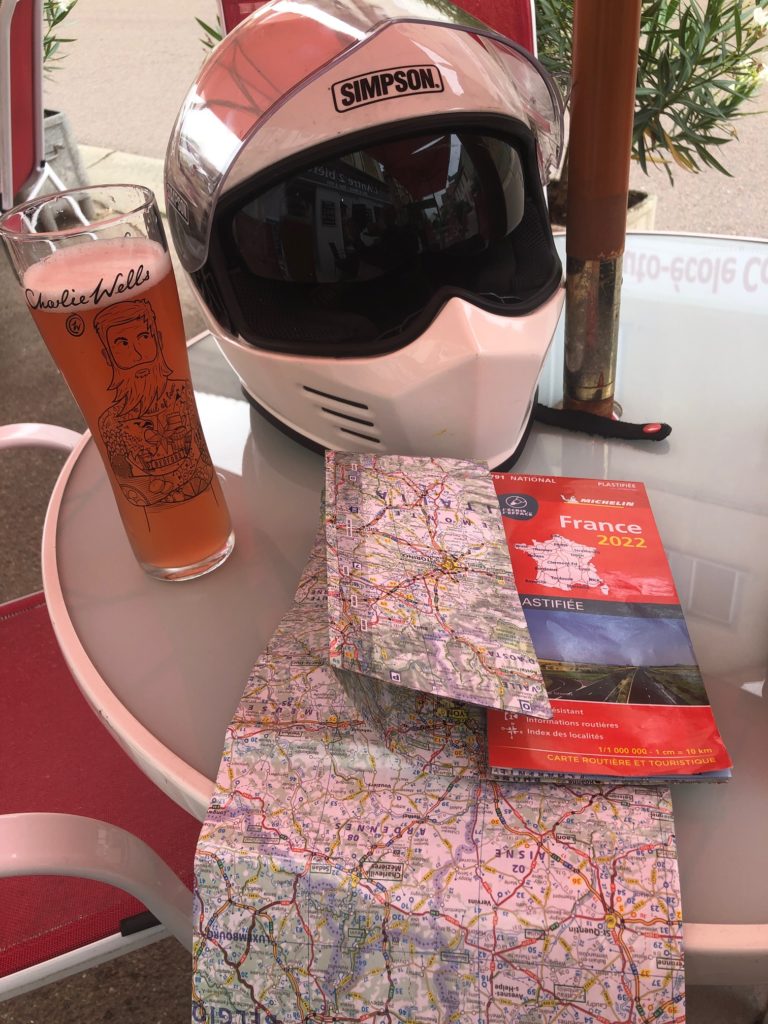 In Burgundy, we made a stop some days to meet some local wine producers, friends of us for a long time. Each time, they permit us to discover some of their …secrets.
In Burgundy, we made a stop some days to meet some local wine producers, friends of us for a long time. Each time, they permit us to discover some of their …secrets.
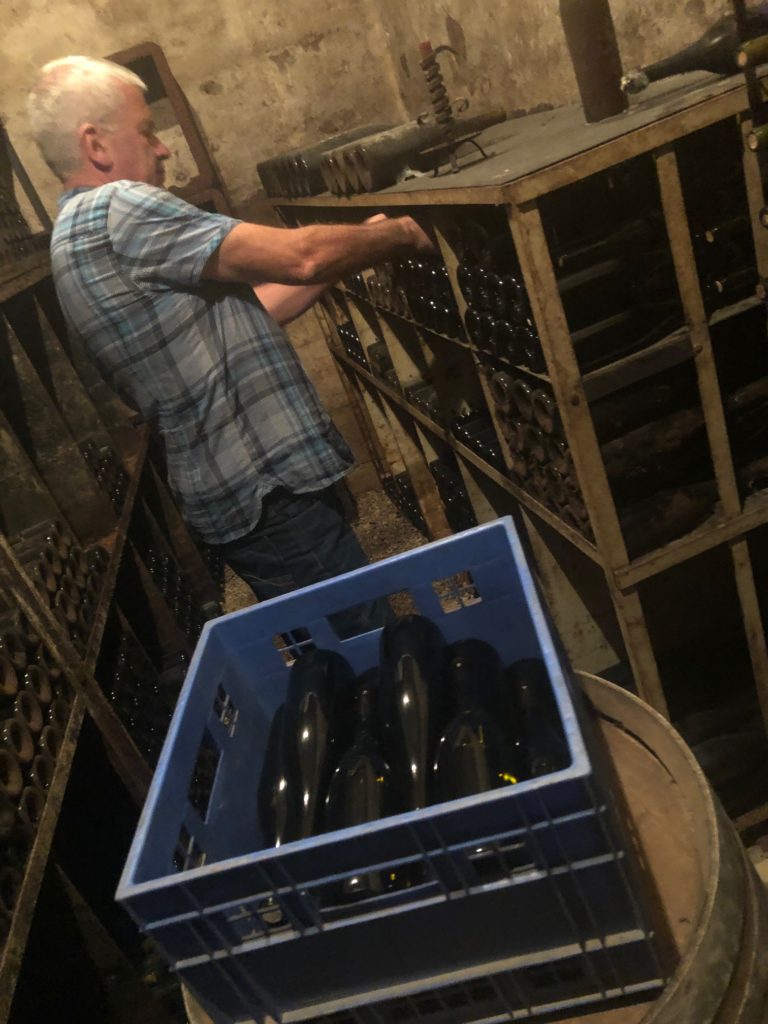 Around of the famous city of BEAUNE, international city of wine …
Around of the famous city of BEAUNE, international city of wine …
 This region of France is maybe one of the most beautiful in France and maybe all over Europe …
This region of France is maybe one of the most beautiful in France and maybe all over Europe …
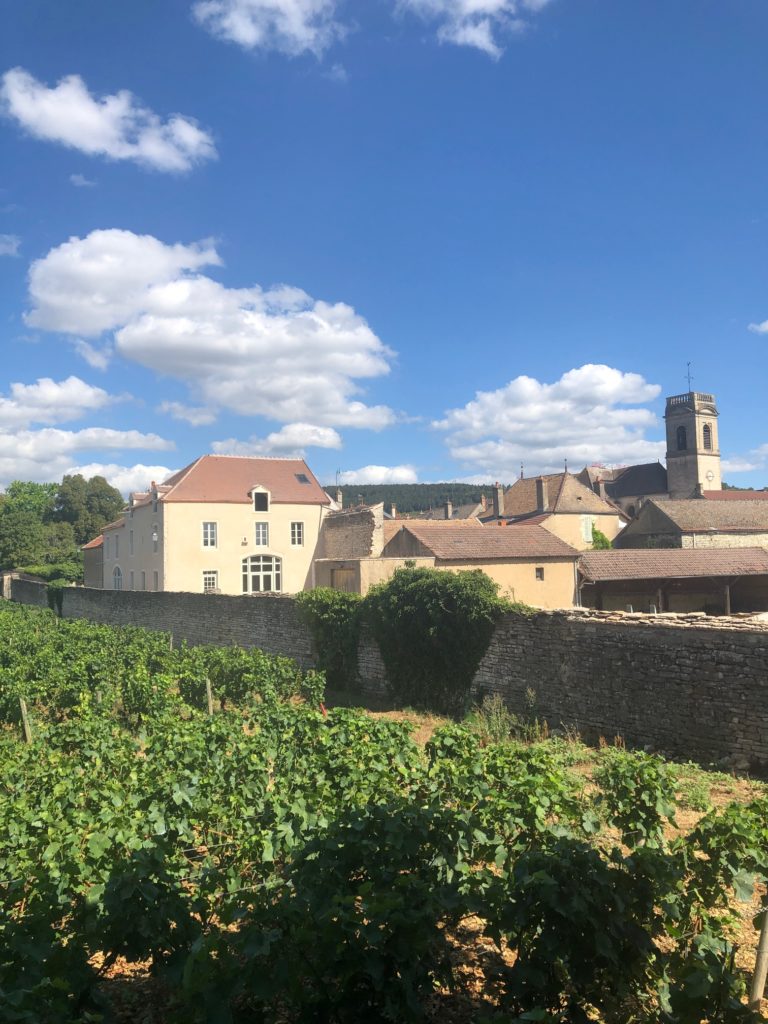 After Burgundy, it was time to go south …
After Burgundy, it was time to go south …
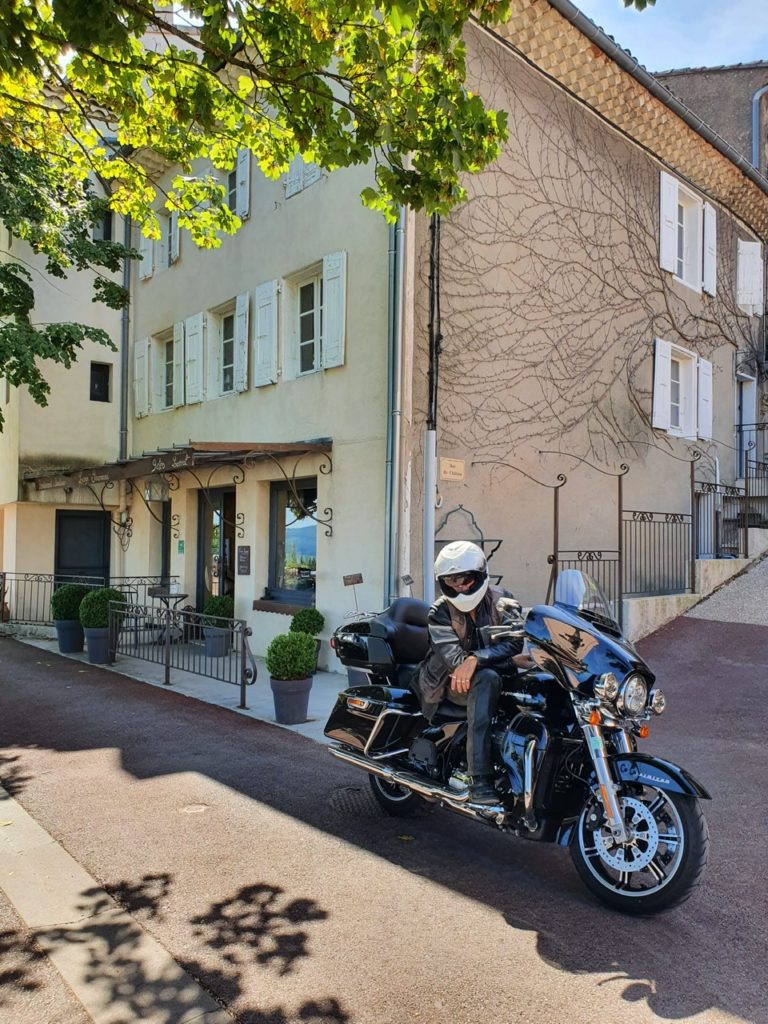 … and enter the ARDECHE and DROME counties.
… and enter the ARDECHE and DROME counties.
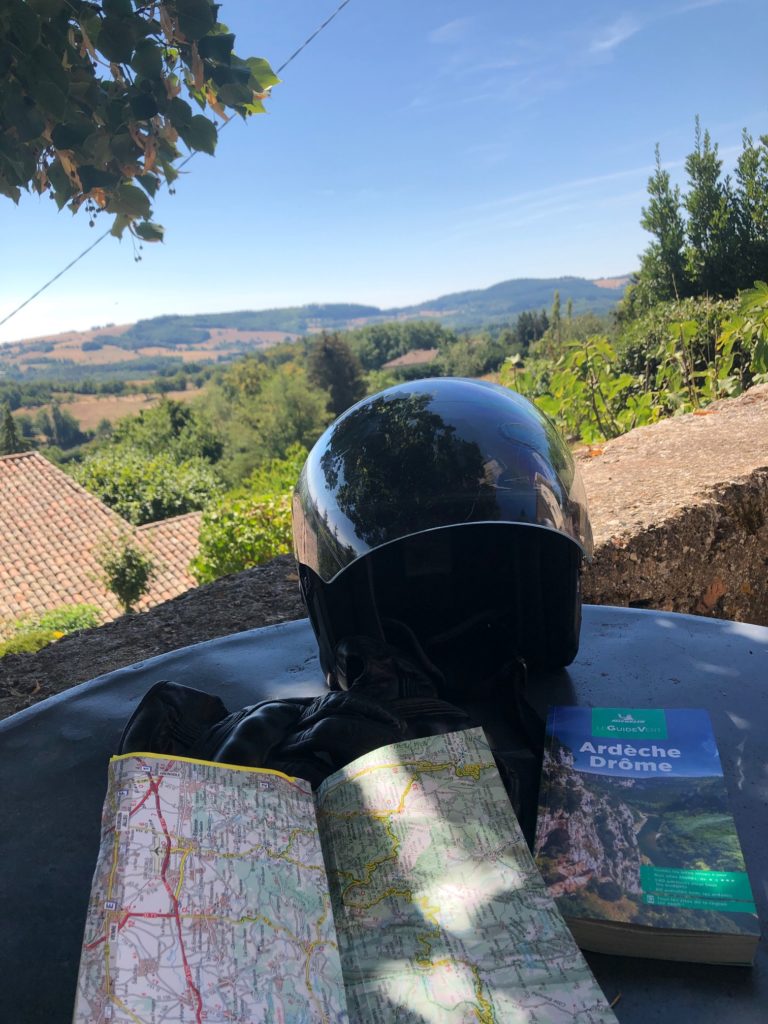 Funny time, we made a stop on the road to sleep in an old French trucks hotels … surprising but very cool experience.
Funny time, we made a stop on the road to sleep in an old French trucks hotels … surprising but very cool experience.
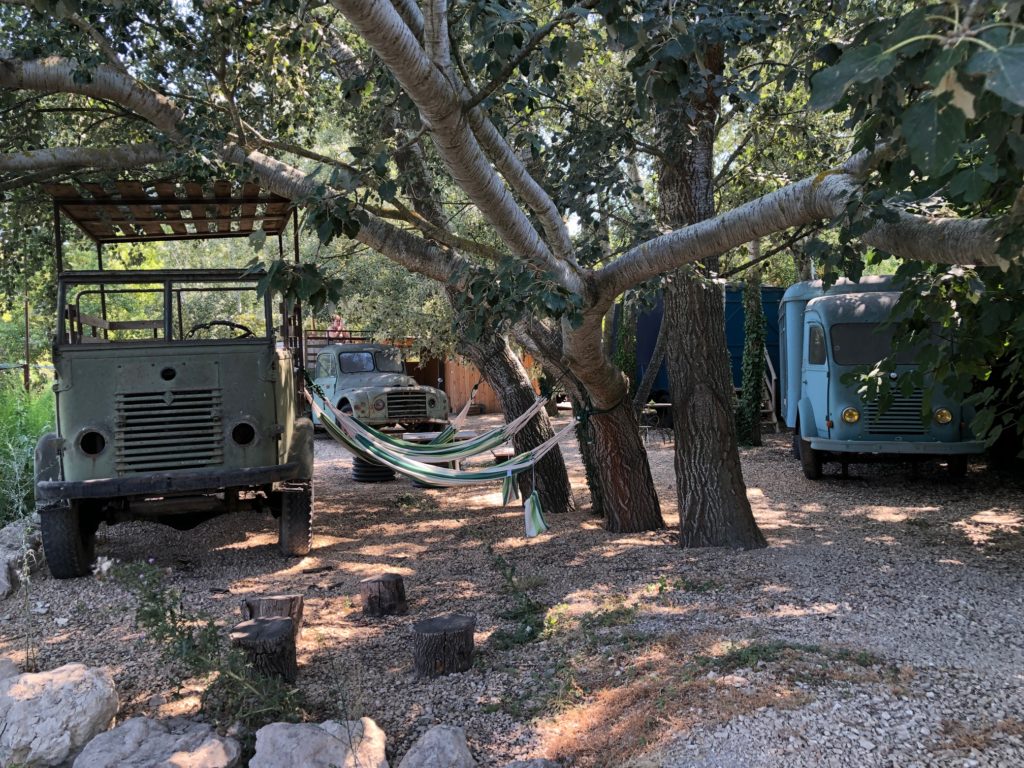 But to be honest, after daily stage of about 400kms/250 miles, we were very attentive to our confort …
But to be honest, after daily stage of about 400kms/250 miles, we were very attentive to our confort …
 We made stop in many different nice places lost in the middle of …nowhere.
We made stop in many different nice places lost in the middle of …nowhere.
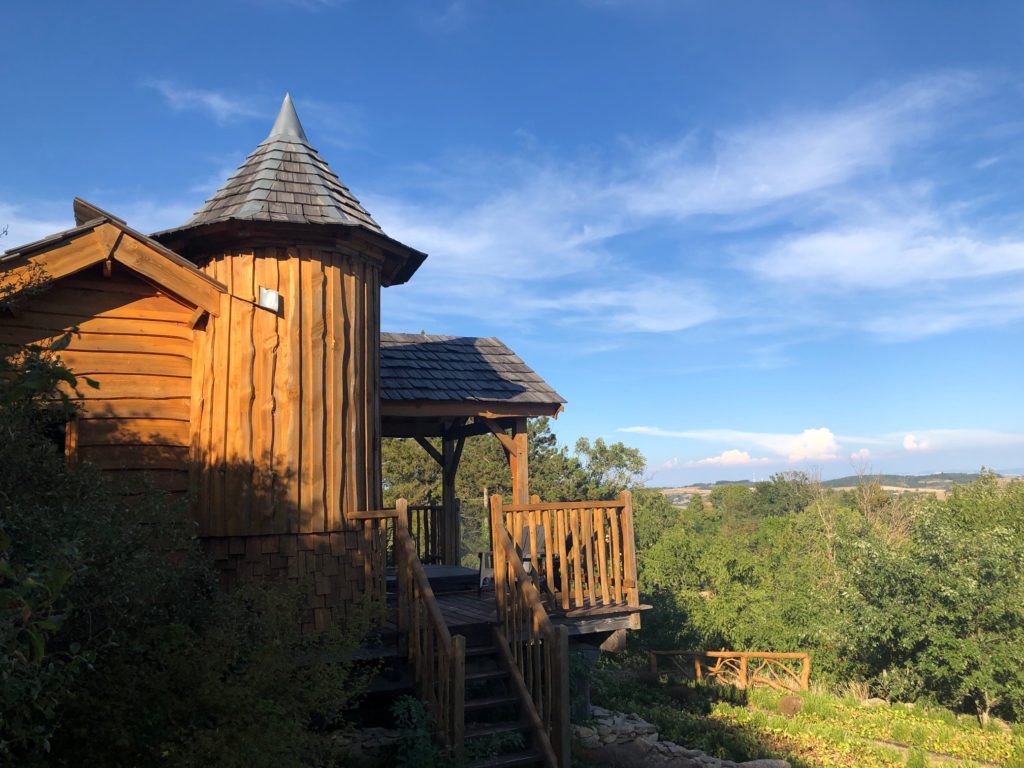 And of course, every dinner was a ceremony …
And of course, every dinner was a ceremony …
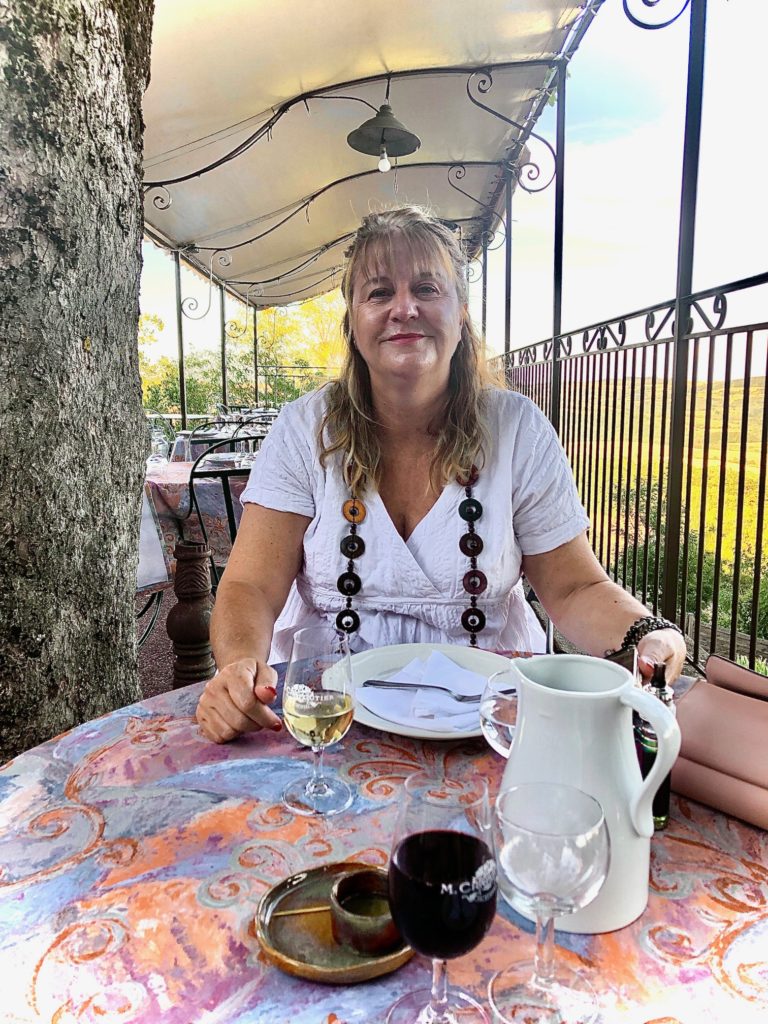 And then, after some days, we finally reached our final destination …
And then, after some days, we finally reached our final destination …
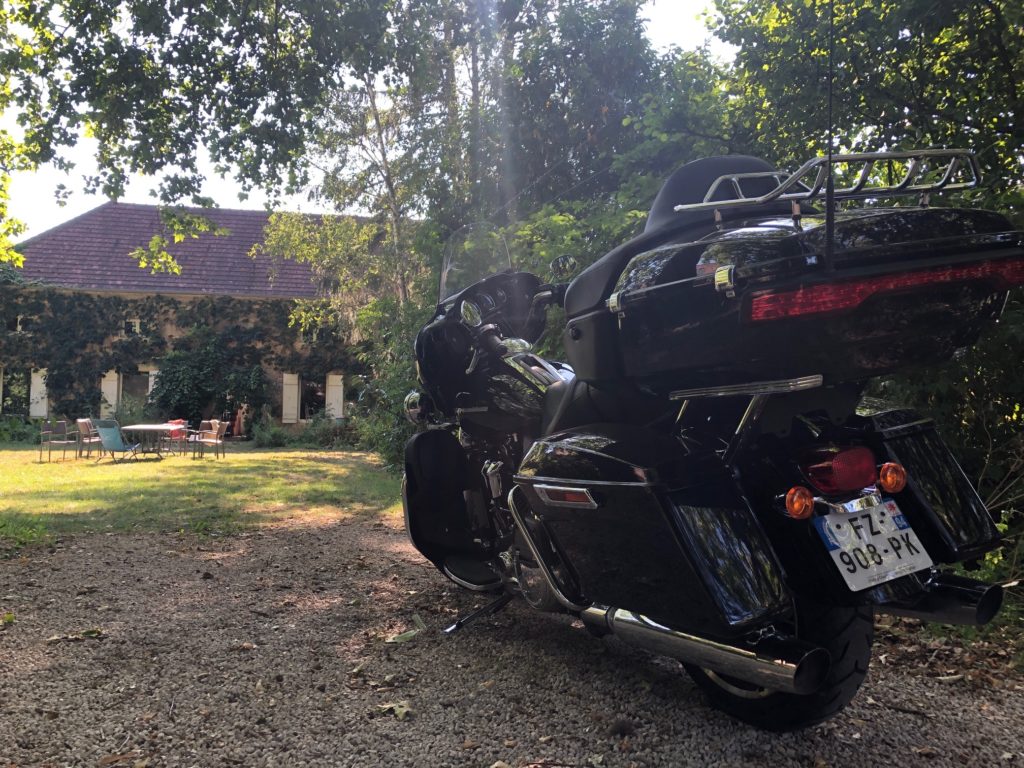 … the IDEAL PALACE of the POSTMAN CHEVAL!
… the IDEAL PALACE of the POSTMAN CHEVAL!
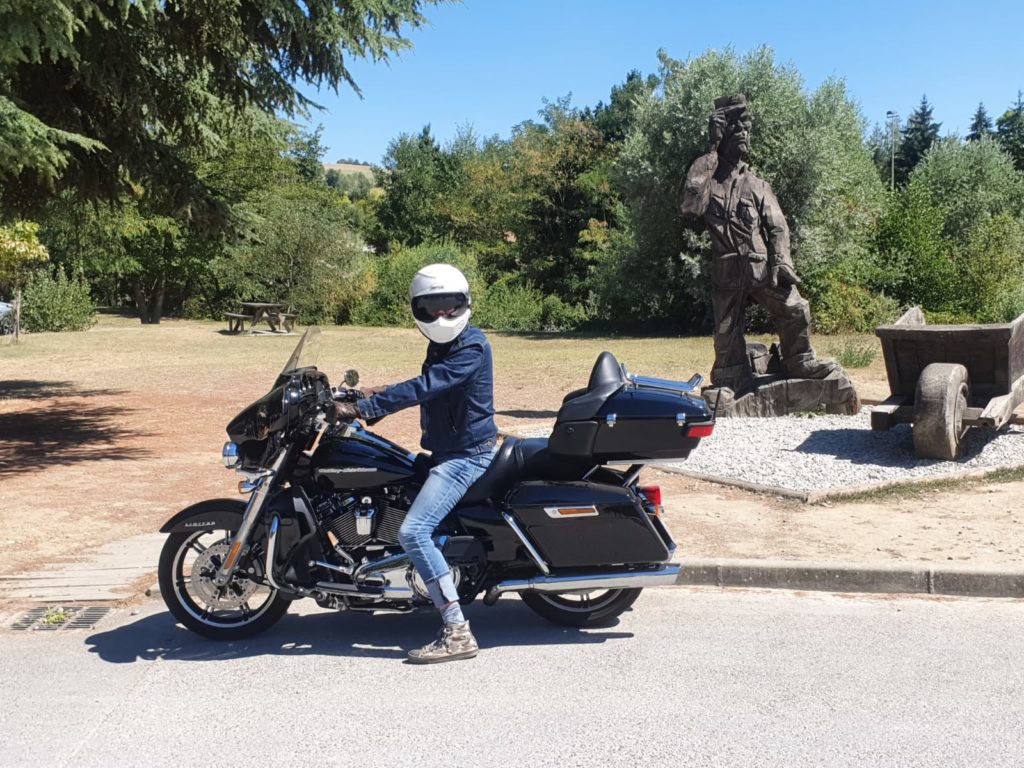 Ferdinand Cheval (19 April 1836 – 19 August 1924), often nicknamed Facteur Cheval (“Mail Carrier Cheval”)] was a French mail carrier who spent thirty-three years of his life building LE PALAIS IDEAL (the “Ideal Palace”) in Hauterives, in southeastern France. The Palace is regarded as an extraordinary example of naïve art architecture.
Ferdinand Cheval (19 April 1836 – 19 August 1924), often nicknamed Facteur Cheval (“Mail Carrier Cheval”)] was a French mail carrier who spent thirty-three years of his life building LE PALAIS IDEAL (the “Ideal Palace”) in Hauterives, in southeastern France. The Palace is regarded as an extraordinary example of naïve art architecture.
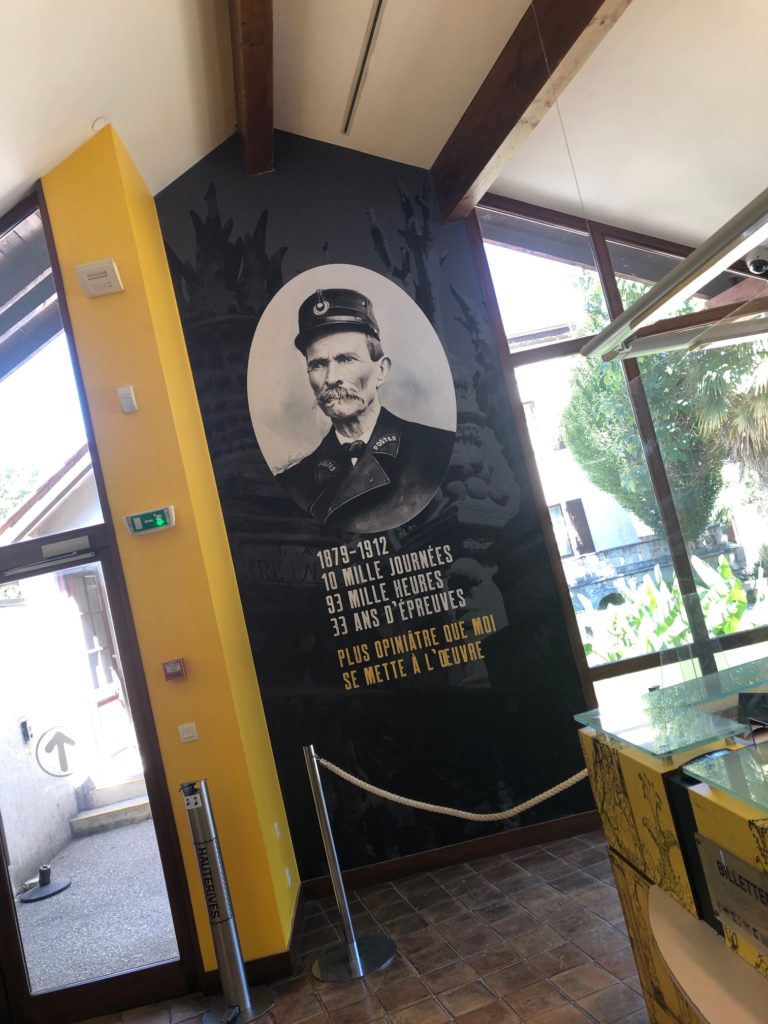 Joseph Ferdinand Cheval was born into a poor farming family. He left school at the age of 13 to become a baker’s apprentice, but eventually became a mail carrier.
Joseph Ferdinand Cheval was born into a poor farming family. He left school at the age of 13 to become a baker’s apprentice, but eventually became a mail carrier.
 Cheval began building the Palais Idéal in April 1879 (143 years ago) when he was 43 years old. He reported: I was walking very fast when my foot caught on something that sent me stumbling a few metres away, I wanted to know the cause. [Previously, in] a dream, I had built a palace, a castle or caves, I cannot express it well… I told no one about it for fear of being ridiculed and I felt ridiculous myself. Then fifteen years later, when I had almost forgotten my dream, when I wasn’t thinking of it at all, my foot reminded me of it. My foot tripped on a stone that almost made me fall. I wanted to know what it was… It was a stone of such a strange shape that I put it in my pocket to admire it at my leisure. The next day, I went back to the same place. I found more stones, even more beautiful, I gathered them together on the spot and was overcome with delight… It’s a sandstone shaped by water and hardened by the power of time. It becomes as hard as pebbles. It represents a sculpture so strange that it is impossible for man to imitate, it represents any kind of animal, any kind of caricature. I said to myself: since Nature is willing to do the sculpture, I will do the masonry and the architecture.
Cheval began building the Palais Idéal in April 1879 (143 years ago) when he was 43 years old. He reported: I was walking very fast when my foot caught on something that sent me stumbling a few metres away, I wanted to know the cause. [Previously, in] a dream, I had built a palace, a castle or caves, I cannot express it well… I told no one about it for fear of being ridiculed and I felt ridiculous myself. Then fifteen years later, when I had almost forgotten my dream, when I wasn’t thinking of it at all, my foot reminded me of it. My foot tripped on a stone that almost made me fall. I wanted to know what it was… It was a stone of such a strange shape that I put it in my pocket to admire it at my leisure. The next day, I went back to the same place. I found more stones, even more beautiful, I gathered them together on the spot and was overcome with delight… It’s a sandstone shaped by water and hardened by the power of time. It becomes as hard as pebbles. It represents a sculpture so strange that it is impossible for man to imitate, it represents any kind of animal, any kind of caricature. I said to myself: since Nature is willing to do the sculpture, I will do the masonry and the architecture.
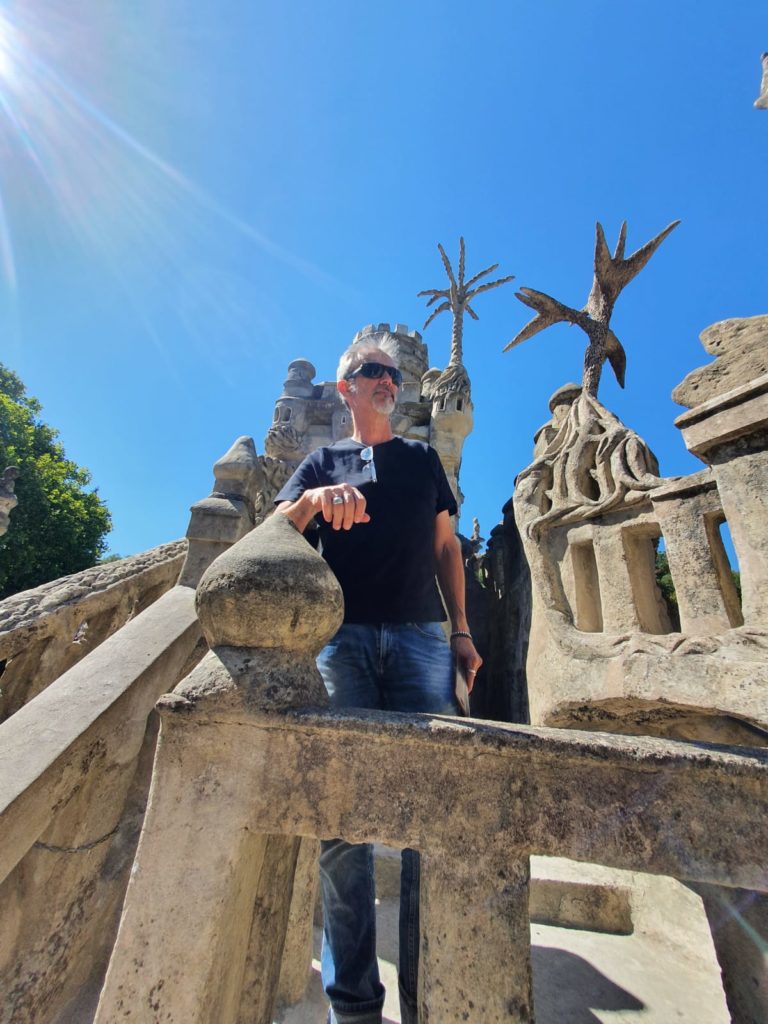 For the next thirty-three years, Cheval picked up stones during his daily mail rounds and carried them home to build the Palais idéal. At first, he carried the stones in his pockets, then switched to a basket. Eventually, he used a wheelbarrow. He often worked at night, by the light of an oil lamp. He spent the first twenty years building the outer walls.
For the next thirty-three years, Cheval picked up stones during his daily mail rounds and carried them home to build the Palais idéal. At first, he carried the stones in his pockets, then switched to a basket. Eventually, he used a wheelbarrow. He often worked at night, by the light of an oil lamp. He spent the first twenty years building the outer walls.
 The palace materials mainly consist of stones (river washed), pebbles, porous tufa and fossils of different shapes and sizes. When visitors arrive at the palace, the first thing they see is the southern facade, approximately 26 metres long and up to 10 metres high. The decoration resembles aspects of both the royal Pavillon in Brighton, England and Gaudi’s Sagrada Familia. Cheval did not travel and had even given himself the title of peasant, so even though some qualities of his work resemble those pieces of art, he had never seen them. Three giant stones, each with doll-like faces, standing about 10.5 high, serve not only as decoration but as a support system for the Barbary Tower, with a line of cement swans leading up to an elegant spiral staircase. The thee giant stones were named after Vercingetorix, Archimedes and Ceasar, the names of each hand-carved by Cheval into each individual figure.
The palace materials mainly consist of stones (river washed), pebbles, porous tufa and fossils of different shapes and sizes. When visitors arrive at the palace, the first thing they see is the southern facade, approximately 26 metres long and up to 10 metres high. The decoration resembles aspects of both the royal Pavillon in Brighton, England and Gaudi’s Sagrada Familia. Cheval did not travel and had even given himself the title of peasant, so even though some qualities of his work resemble those pieces of art, he had never seen them. Three giant stones, each with doll-like faces, standing about 10.5 high, serve not only as decoration but as a support system for the Barbary Tower, with a line of cement swans leading up to an elegant spiral staircase. The thee giant stones were named after Vercingetorix, Archimedes and Ceasar, the names of each hand-carved by Cheval into each individual figure.
 The north facade exhibits a long path dotted with large openings to provide plentiful light leading into the heart of the palace itself. This facade is strikingly forest-like: walls are coated in moss and massive seaweed. The ceiling’s swirling patterns of pebbles and shells outline the chandeliers. Upper walls are lined with horizontal bands that have animals carved into them, Egyptian style. Other animals on the north facade include two ostriches (presumably mother and father) and an ostrich chick, a 1.2m tall camel, flamingos, octopuses, lions, dragons, and a polar bear.
The north facade exhibits a long path dotted with large openings to provide plentiful light leading into the heart of the palace itself. This facade is strikingly forest-like: walls are coated in moss and massive seaweed. The ceiling’s swirling patterns of pebbles and shells outline the chandeliers. Upper walls are lined with horizontal bands that have animals carved into them, Egyptian style. Other animals on the north facade include two ostriches (presumably mother and father) and an ostrich chick, a 1.2m tall camel, flamingos, octopuses, lions, dragons, and a polar bear.
The east facade took the longest to build before, a shocking 20 years. This face includes ‘The Temple of Nature’, an Egyptian style temple-like structure supported by large, thick sandstone columns. It includes two waterfalls called the Source of Life and the Source of Wisdom.
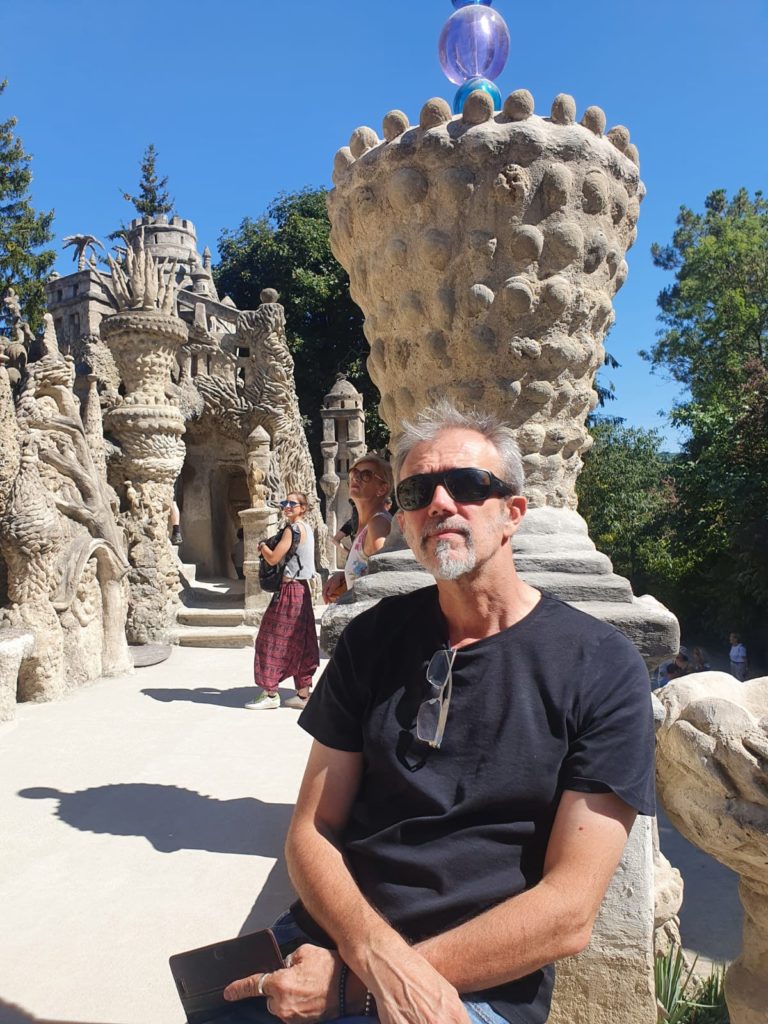 The Palais is a mix of different styles with inspirations from Christianity to Hinduism. Cheval bound the stones together with lime, mortar and cement.
The Palais is a mix of different styles with inspirations from Christianity to Hinduism. Cheval bound the stones together with lime, mortar and cement.
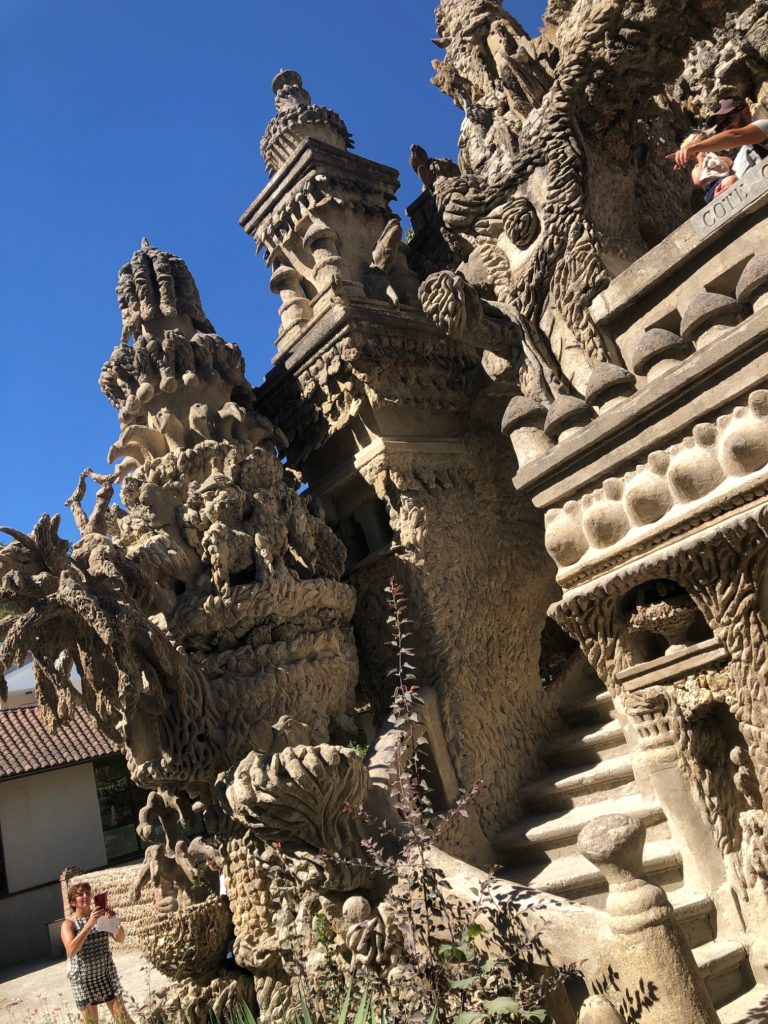 The palace is sprinkled with short quotes and poems hand-carved by Cheval himself. Some examples being “If you look for gold you will find it in elbow grease.”, “The Pantheon of an obscure hero”, “The work of one man”, “Out of a dream I have brought forth the Queen of the World”, “This is of art, and of energy”, “The ecstasy of a beautiful dream and the prize of effort”, “Dream of a peasant”, “Temple of Life”, and “Palace of the Imagination”. Perhaps the most iconic phrase he inscribed on the wall reads “1879-1912 10,000 days, 93,000 hours, 33 years of struggle. Let those who think they can do better try.”
The palace is sprinkled with short quotes and poems hand-carved by Cheval himself. Some examples being “If you look for gold you will find it in elbow grease.”, “The Pantheon of an obscure hero”, “The work of one man”, “Out of a dream I have brought forth the Queen of the World”, “This is of art, and of energy”, “The ecstasy of a beautiful dream and the prize of effort”, “Dream of a peasant”, “Temple of Life”, and “Palace of the Imagination”. Perhaps the most iconic phrase he inscribed on the wall reads “1879-1912 10,000 days, 93,000 hours, 33 years of struggle. Let those who think they can do better try.”
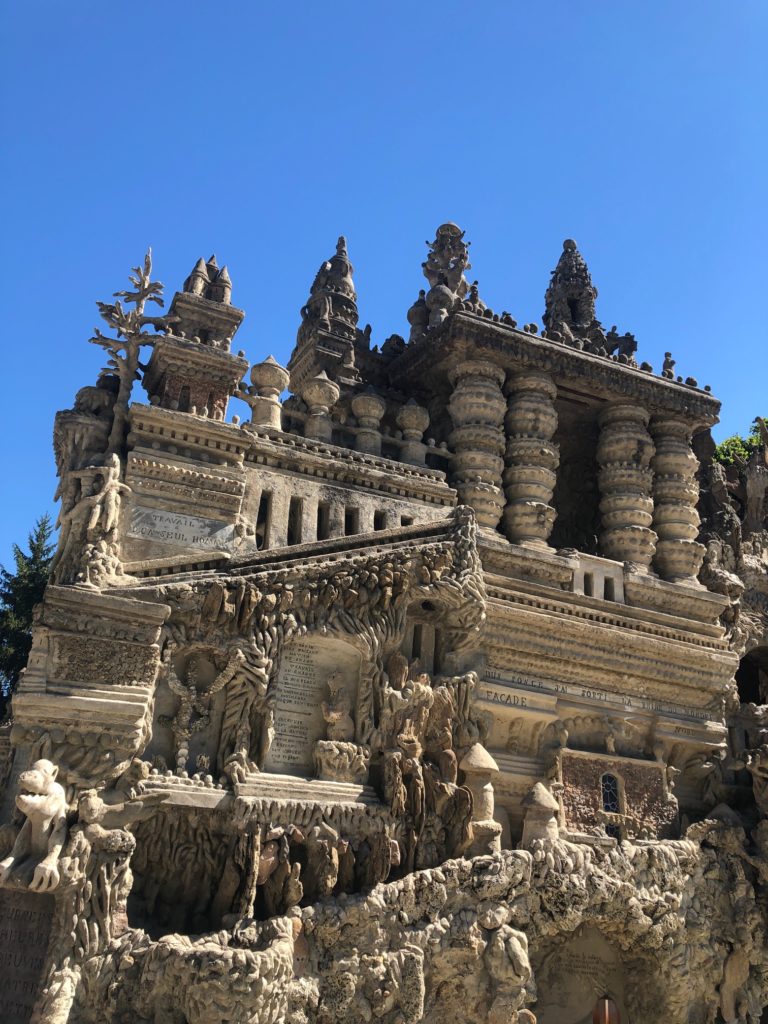 Just before his death, Cheval received recognition from figures including André Breton, Bernard Buffet, Jean Tinguely, niki de Saint Phalle, Robert Doisneau and Pablo Picasso. His work is commemorated in an essay by Anaïs Nin. In 1932, the German artist Max Ernst created a collage titled The Postman Cheval. The collage belongs to the Peggy Guggenheim Collection and is on display there. In 1958, Ado Kyrou produced Le Palais idéal, a short film about Cheval’s palace.
Just before his death, Cheval received recognition from figures including André Breton, Bernard Buffet, Jean Tinguely, niki de Saint Phalle, Robert Doisneau and Pablo Picasso. His work is commemorated in an essay by Anaïs Nin. In 1932, the German artist Max Ernst created a collage titled The Postman Cheval. The collage belongs to the Peggy Guggenheim Collection and is on display there. In 1958, Ado Kyrou produced Le Palais idéal, a short film about Cheval’s palace.
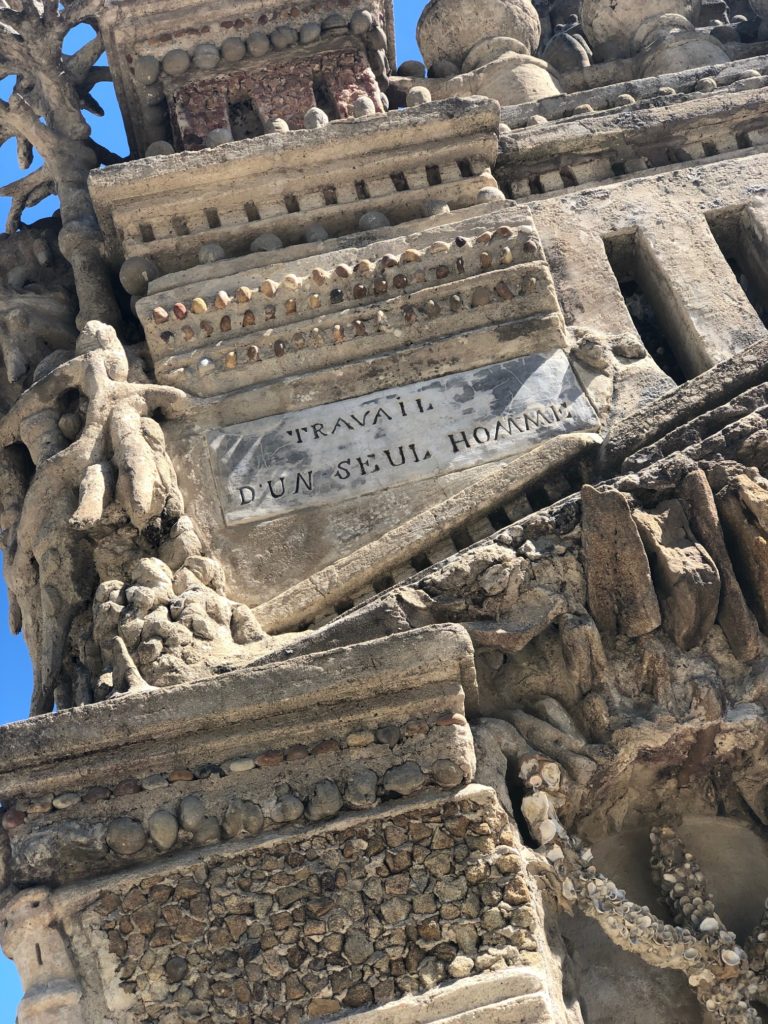 After admiring Cheval’s work, Picasso created a series of drawings telling a narrative, in a cartoon fashion, which is now recognized as Facteur Cheval sketchbook in 1937. Picasso drew him as twisted, hybrid-like creature (or beast), carved with the initials of the French postal service (P.T.T) on his skin, dressed in typical postman’s attire, holding masonry tools and a letter. The creature was standing in front of his creation. In the drawing, Picasso took a humorous route sketching Cheval’s body in the shape of a horse and his head that of a bird. Picasso did this in an effort to make a sort of pun about Cheval’s name and career given birds are messengers (as Cheval was a postman) and the meaning of Cheval is horse.
After admiring Cheval’s work, Picasso created a series of drawings telling a narrative, in a cartoon fashion, which is now recognized as Facteur Cheval sketchbook in 1937. Picasso drew him as twisted, hybrid-like creature (or beast), carved with the initials of the French postal service (P.T.T) on his skin, dressed in typical postman’s attire, holding masonry tools and a letter. The creature was standing in front of his creation. In the drawing, Picasso took a humorous route sketching Cheval’s body in the shape of a horse and his head that of a bird. Picasso did this in an effort to make a sort of pun about Cheval’s name and career given birds are messengers (as Cheval was a postman) and the meaning of Cheval is horse.
 In 1969, André Malraux, the French Minister of culture, declared the Palais a cultural landmark and had it officially protected. In 1986, Cheval was put on a French postage stamp.
In 1969, André Malraux, the French Minister of culture, declared the Palais a cultural landmark and had it officially protected. In 1986, Cheval was put on a French postage stamp.
 In 2018 French director Nils Tavernier released the feature film L’incroyable histoire du facteur Cheval, English title: Ideal Palace, about Cheval’s life and work, with Jacques Gamblin starring as Postman Cheval.
In 2018 French director Nils Tavernier released the feature film L’incroyable histoire du facteur Cheval, English title: Ideal Palace, about Cheval’s life and work, with Jacques Gamblin starring as Postman Cheval.
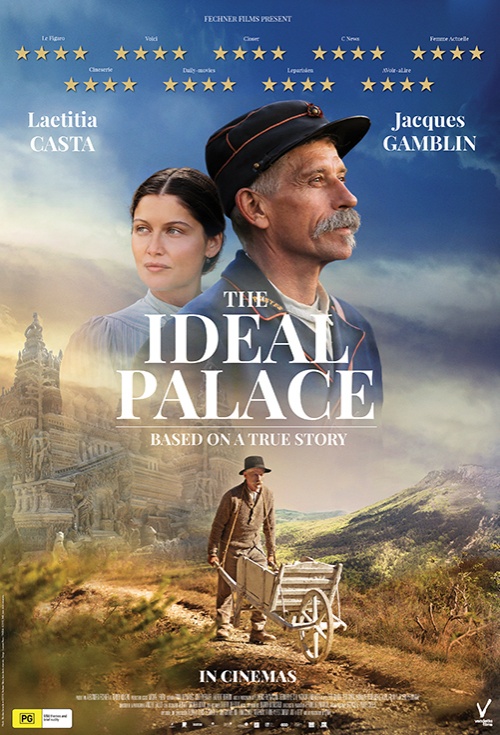 Cheval wanted to be buried in his palace.
Cheval wanted to be buried in his palace.
 Because that is illegal in France, he spent eight more years building a mausoleum for himself in the Hauterives cemetery.
Because that is illegal in France, he spent eight more years building a mausoleum for himself in the Hauterives cemetery.
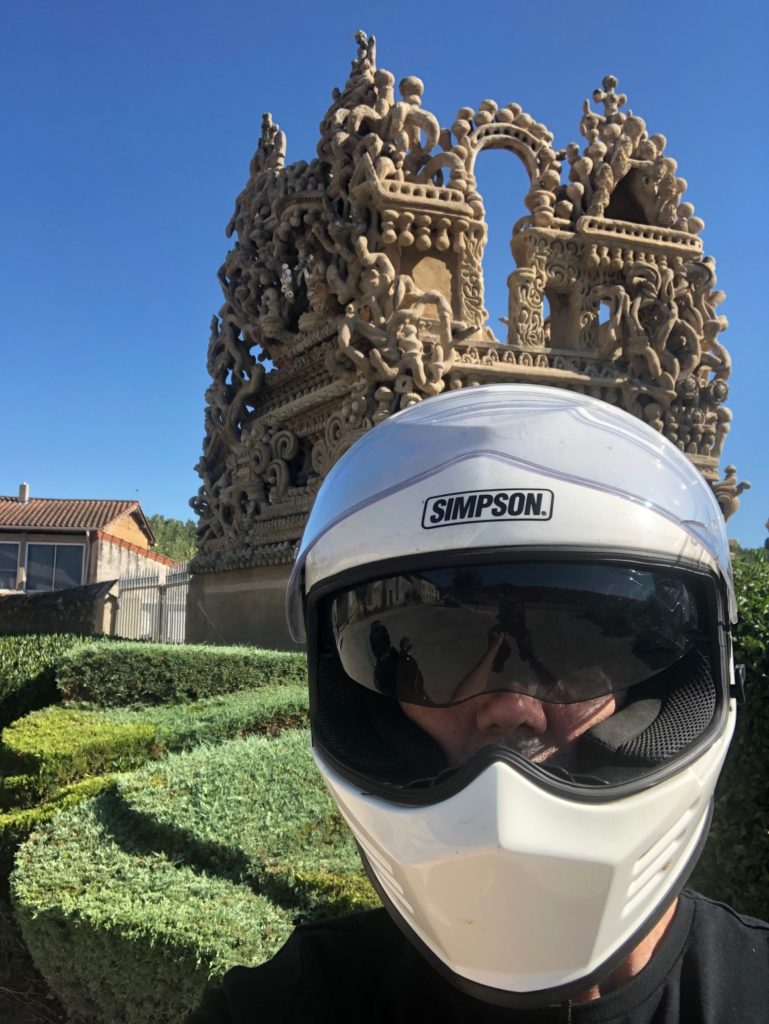 He died on 19 August 1924, about a year after he had finished building it, and is buried there.
He died on 19 August 1924, about a year after he had finished building it, and is buried there.
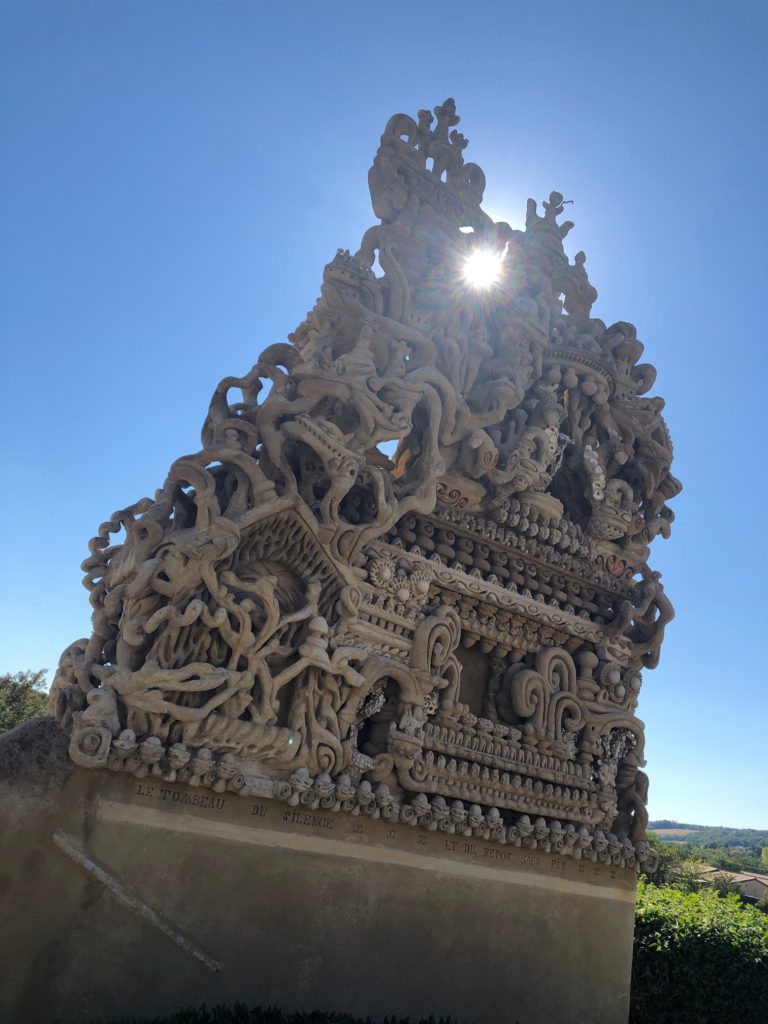 Hope you like the story of this simple man who built alone his dreams …
Hope you like the story of this simple man who built alone his dreams …
 Whatever it may be, next time you will spend some time in France, have a stop in Hauterives to visit the Ideal Palace, it really worths it.
Whatever it may be, next time you will spend some time in France, have a stop in Hauterives to visit the Ideal Palace, it really worths it.
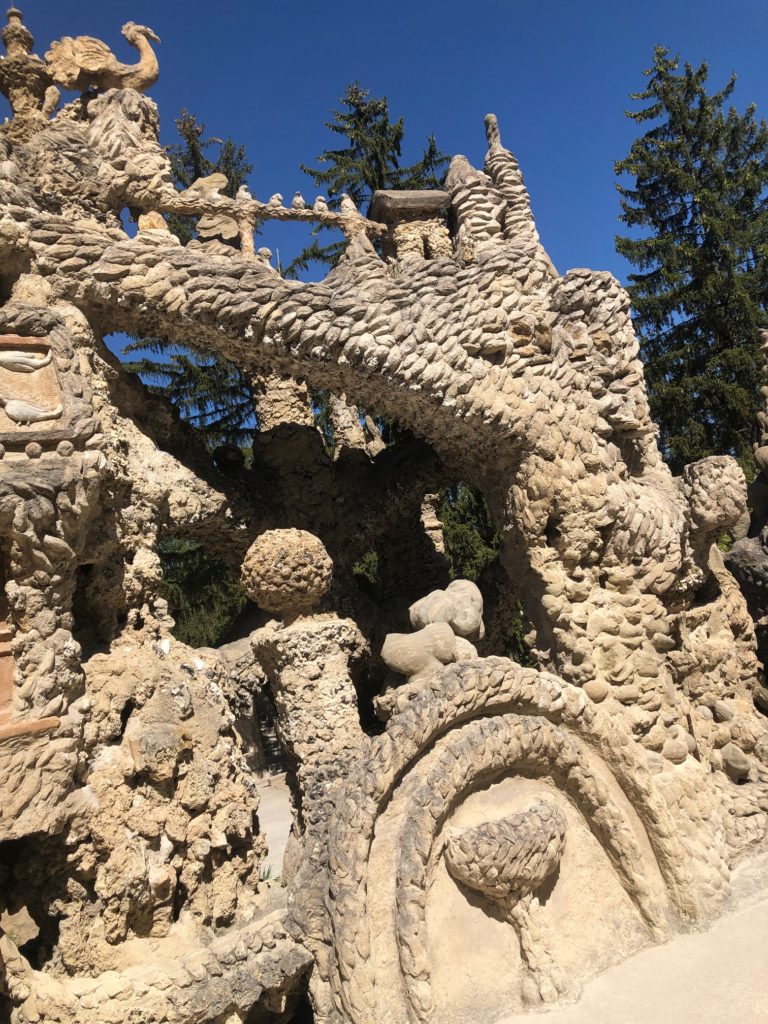 See ya soon on the road …who knows?!?!,
See ya soon on the road …who knows?!?!,
Hervé your French biker friend.





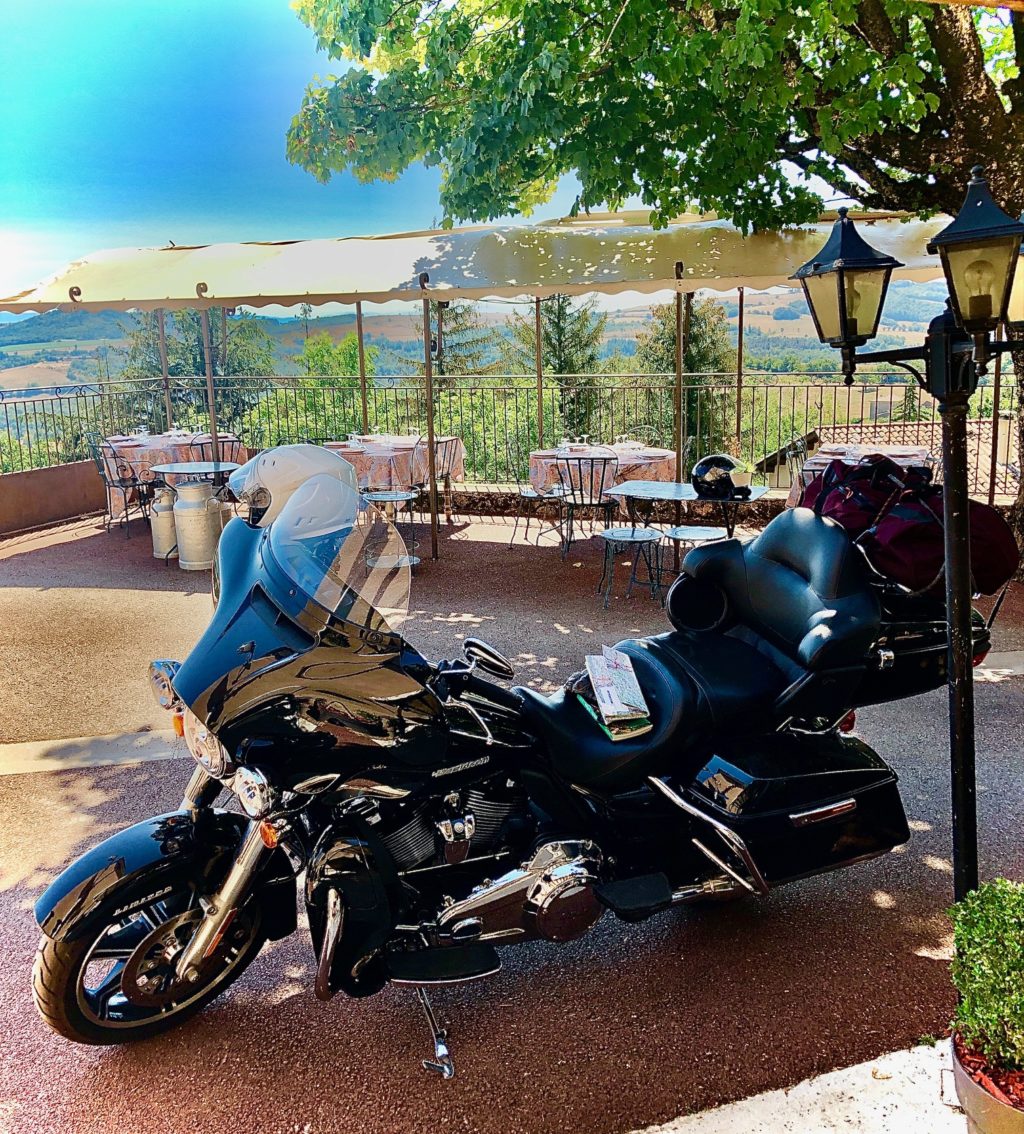
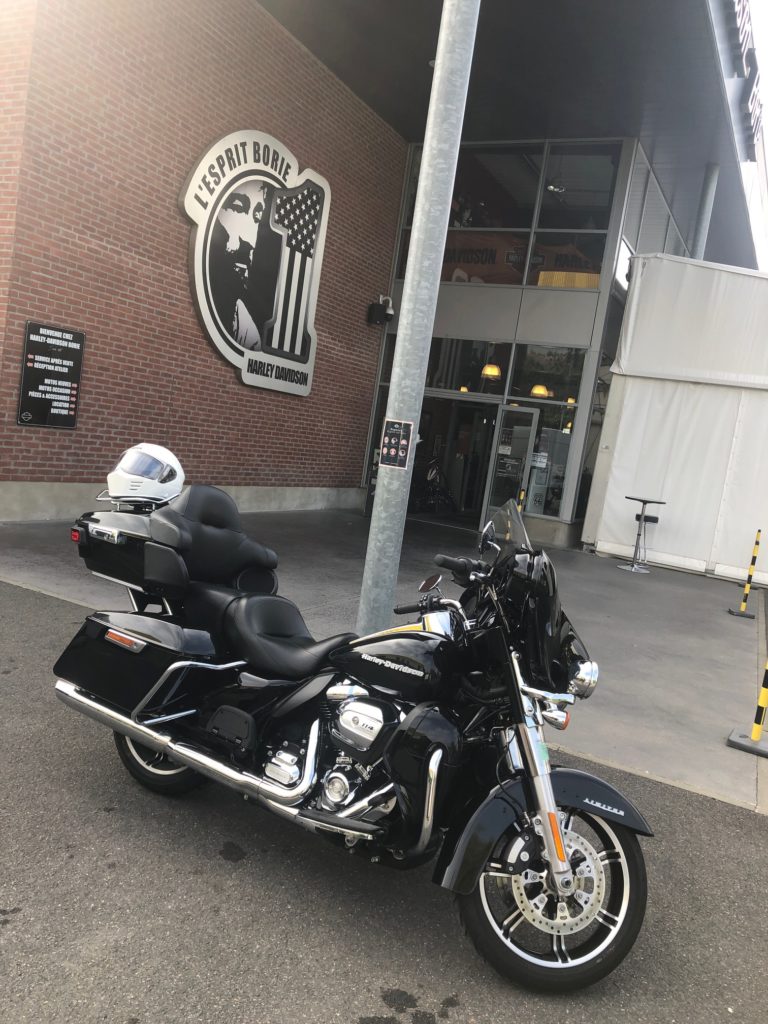
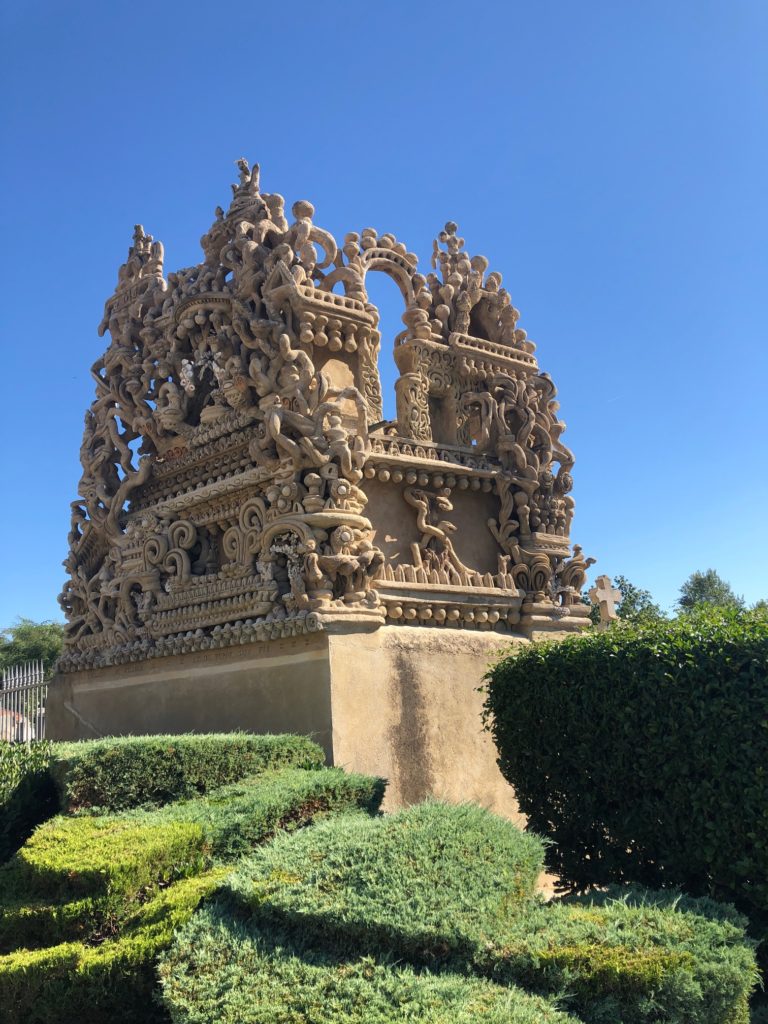

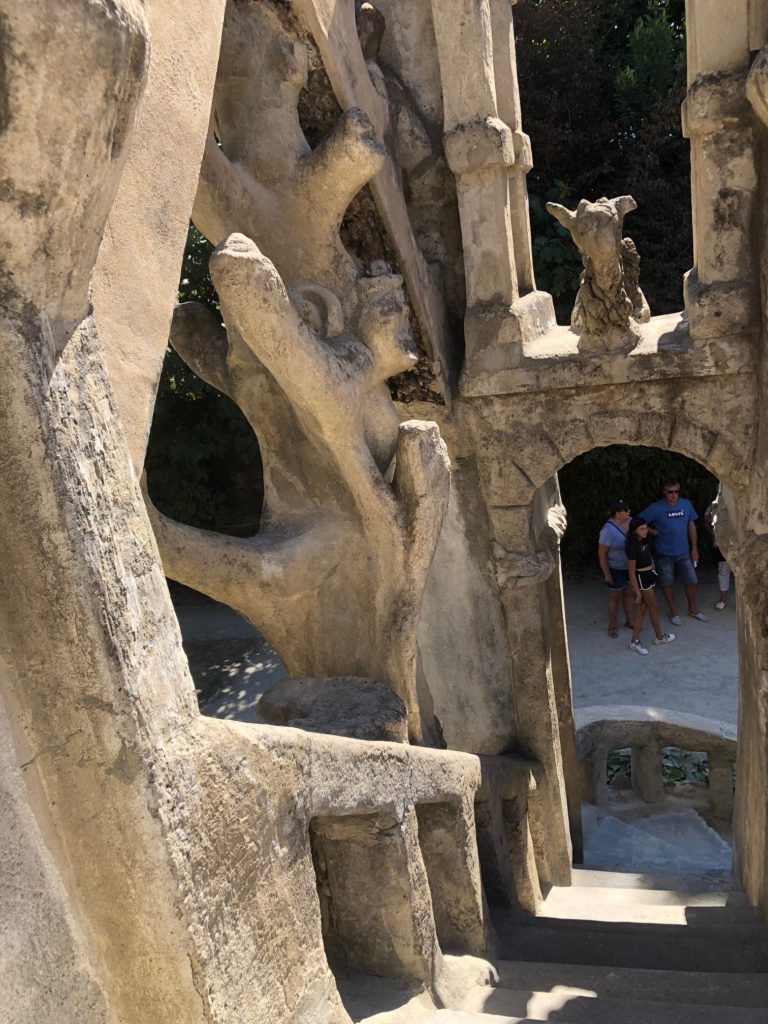
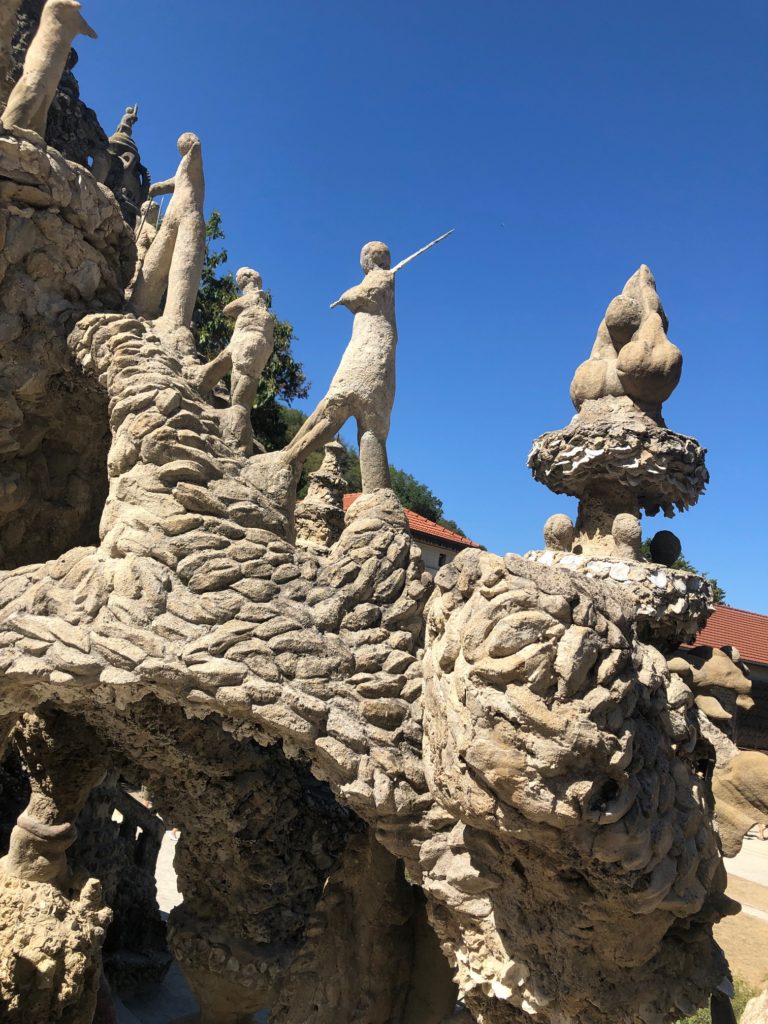
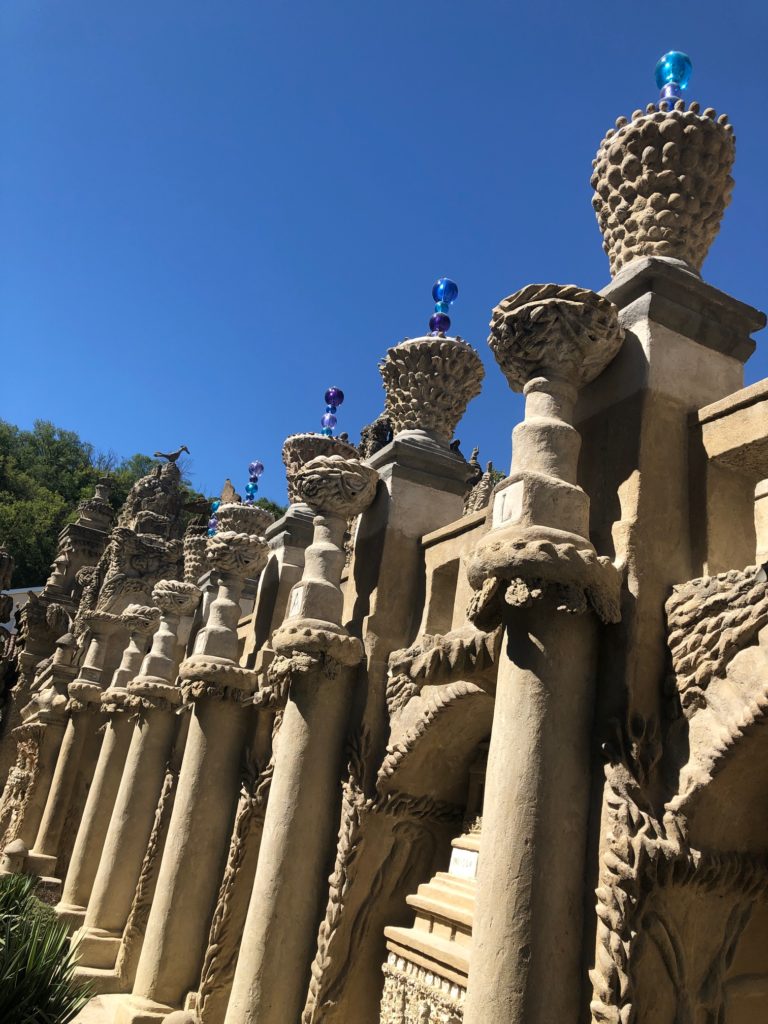
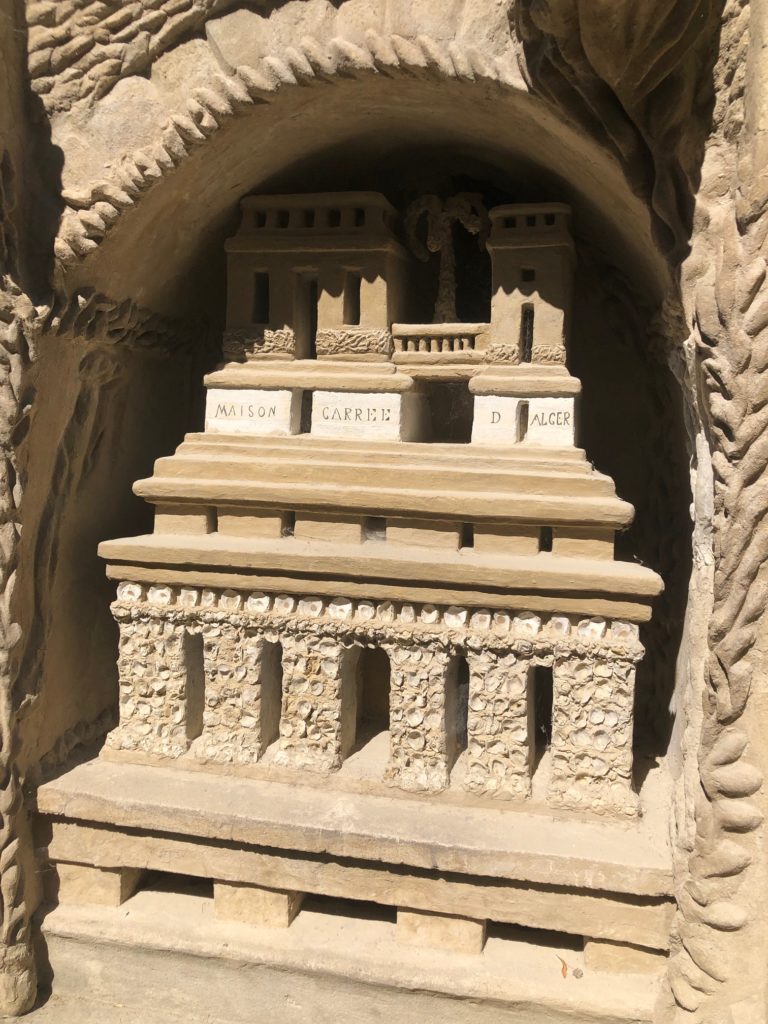

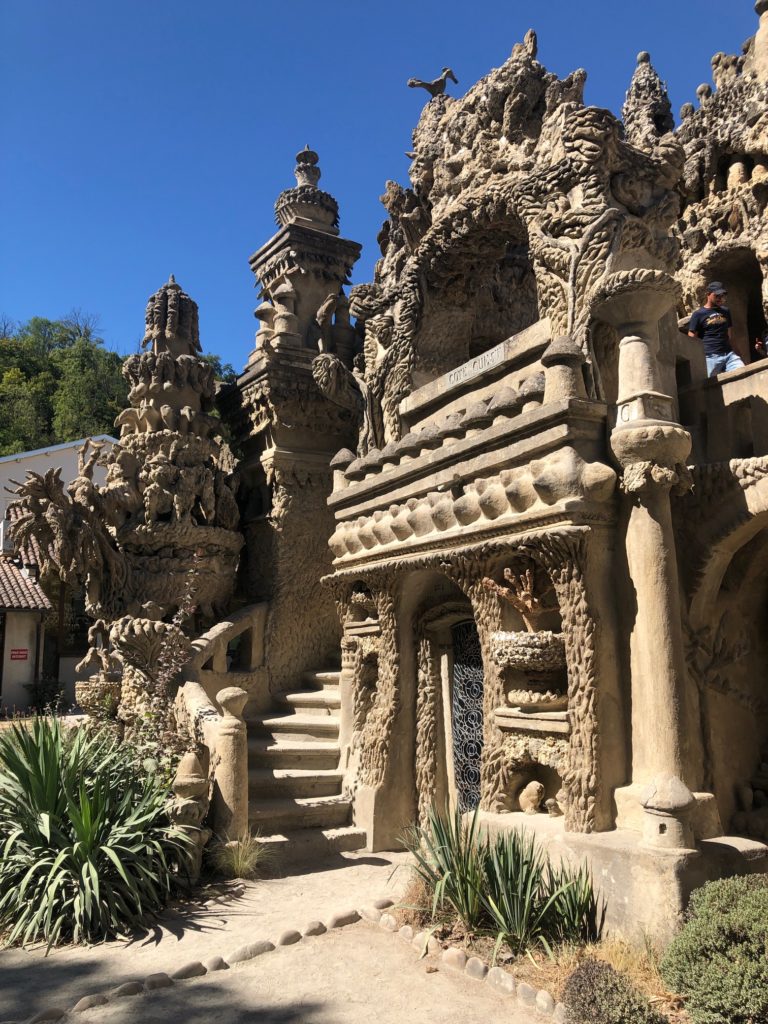
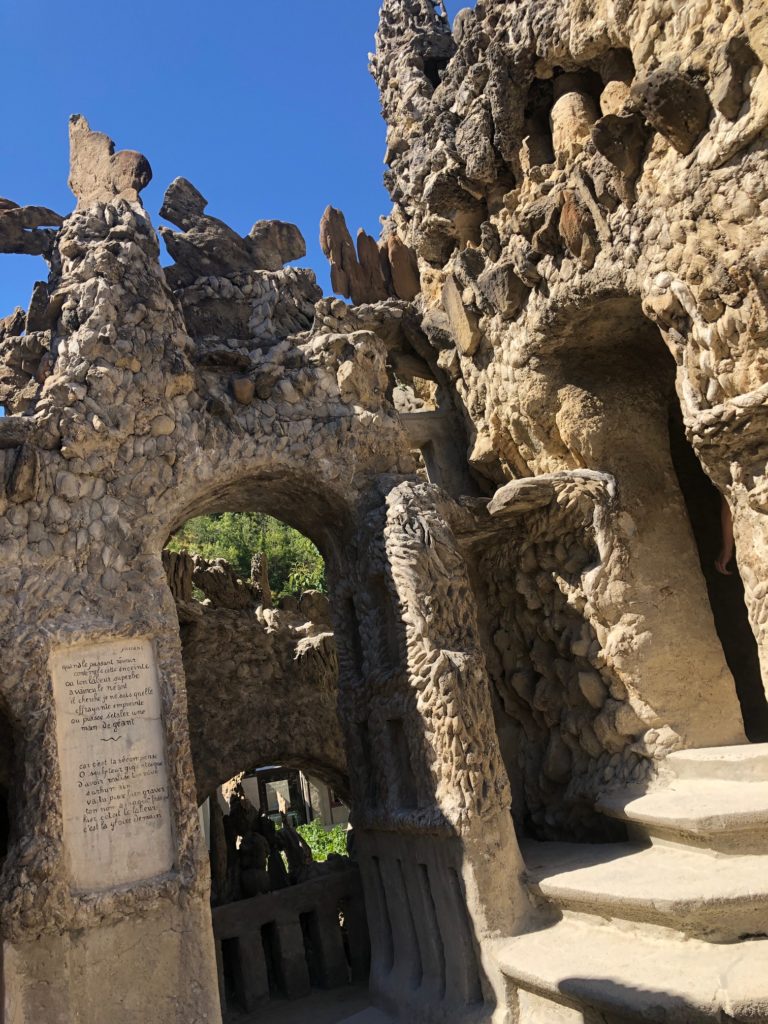
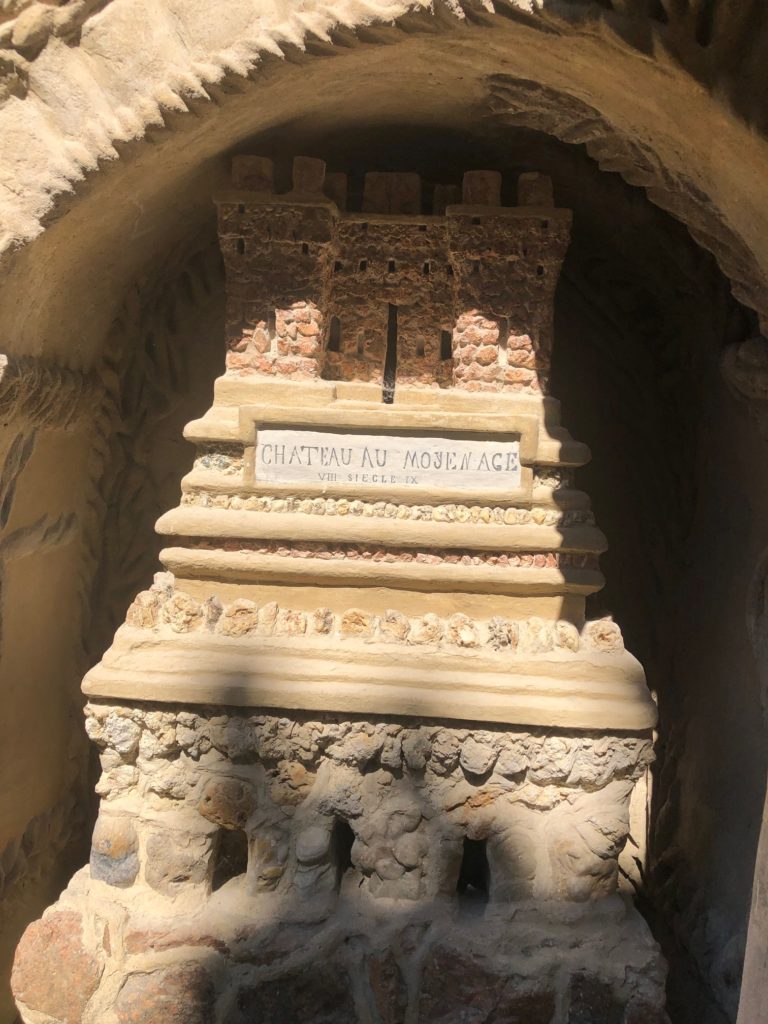
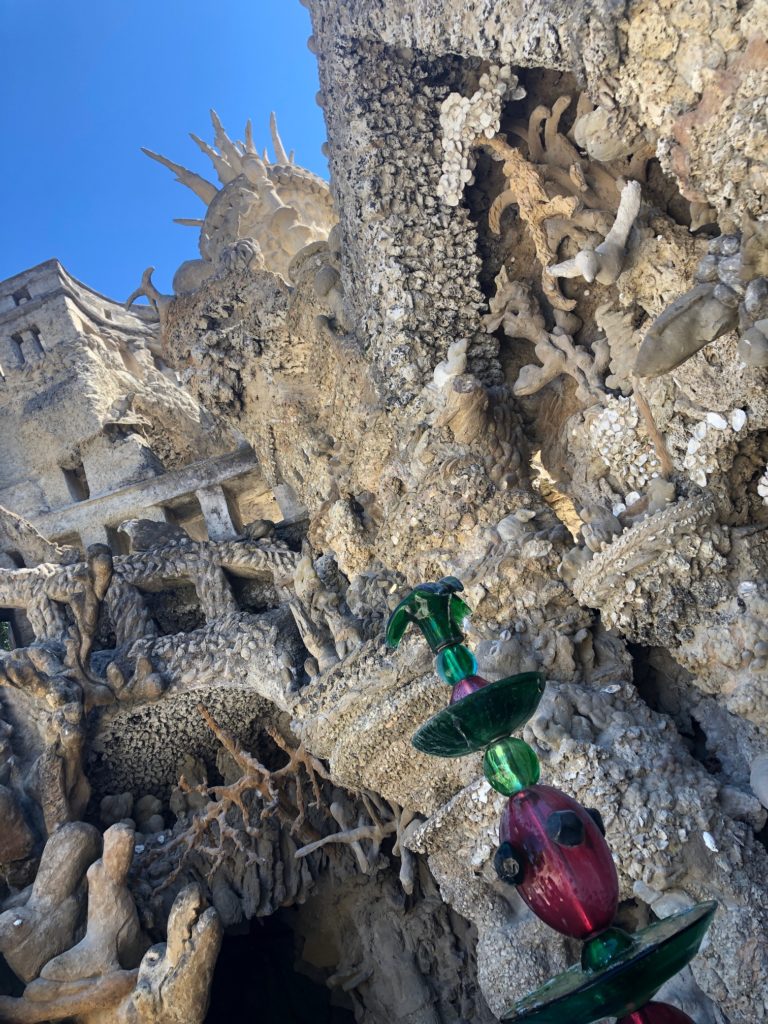

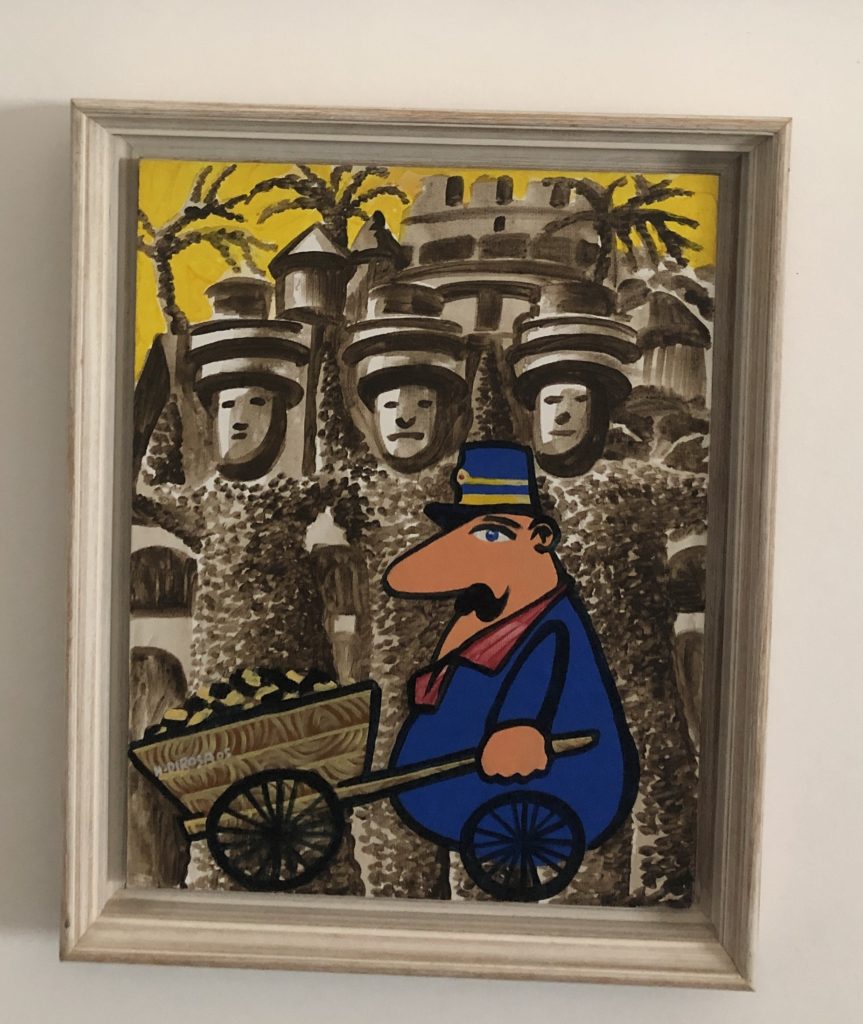


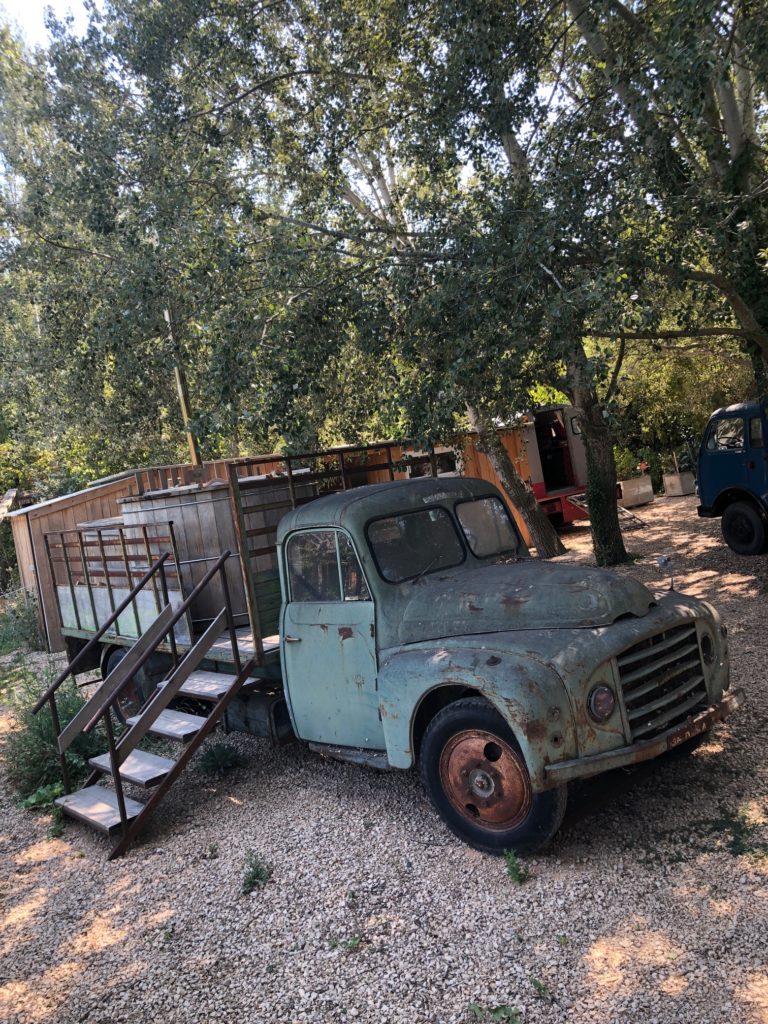
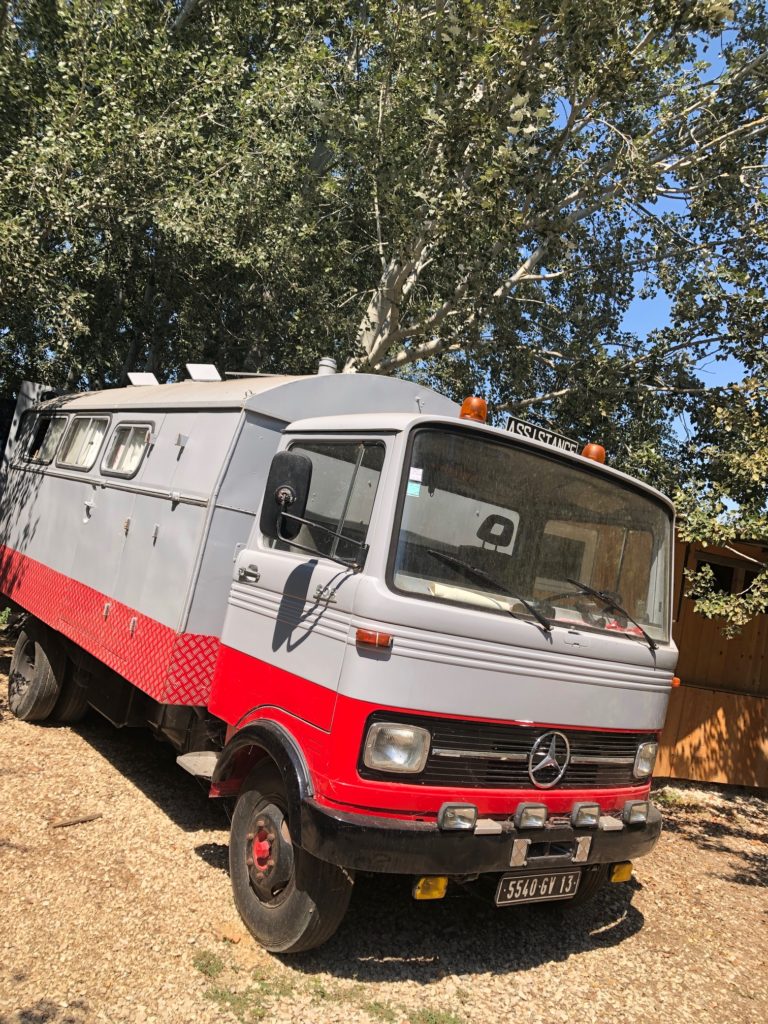
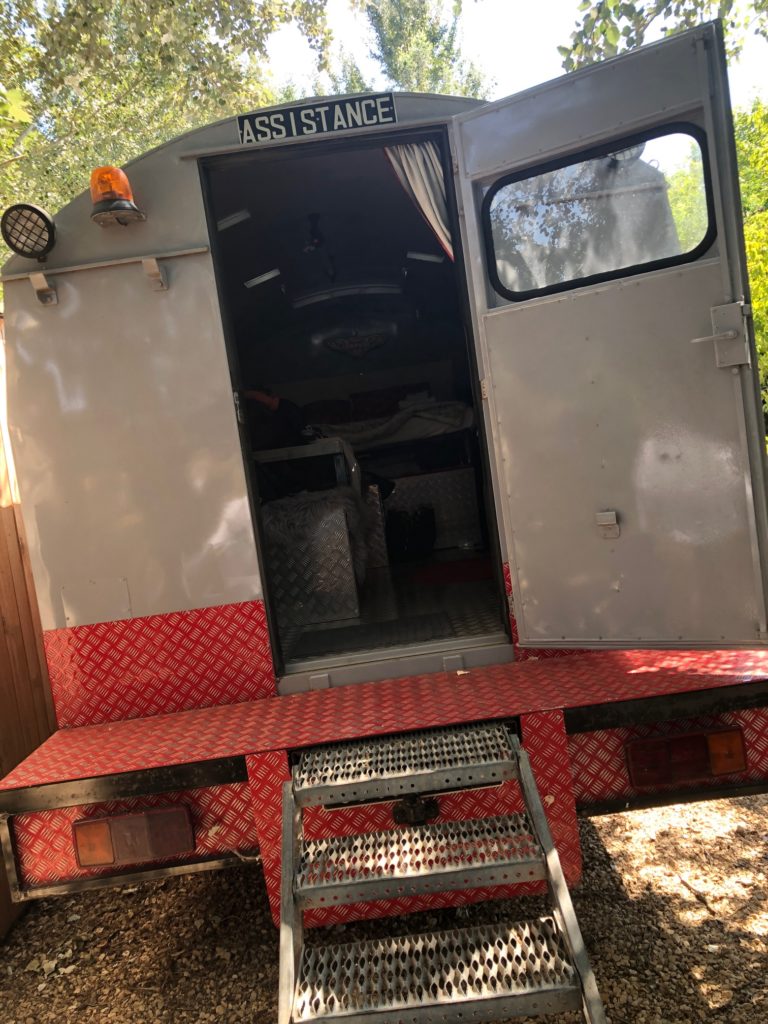
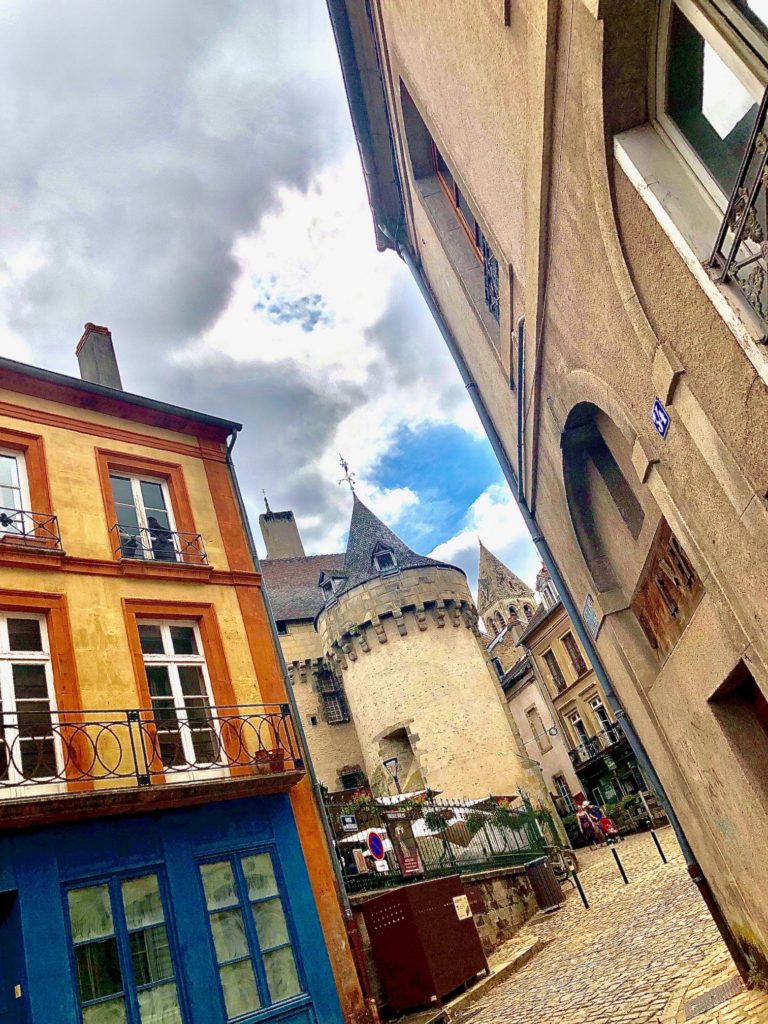

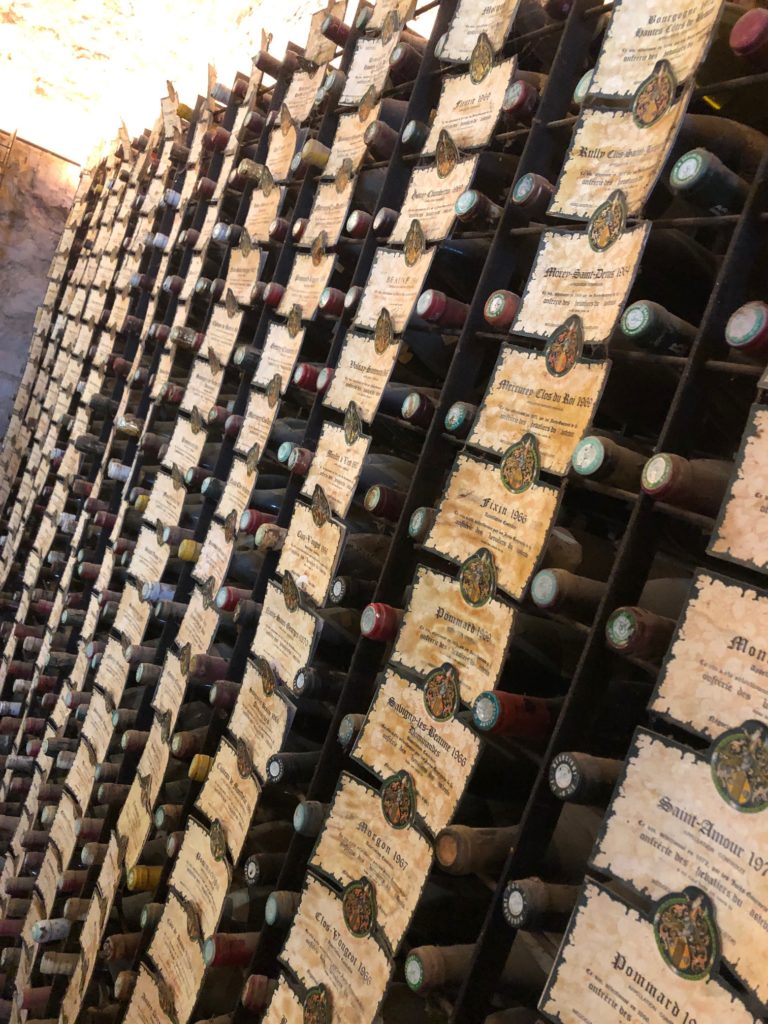
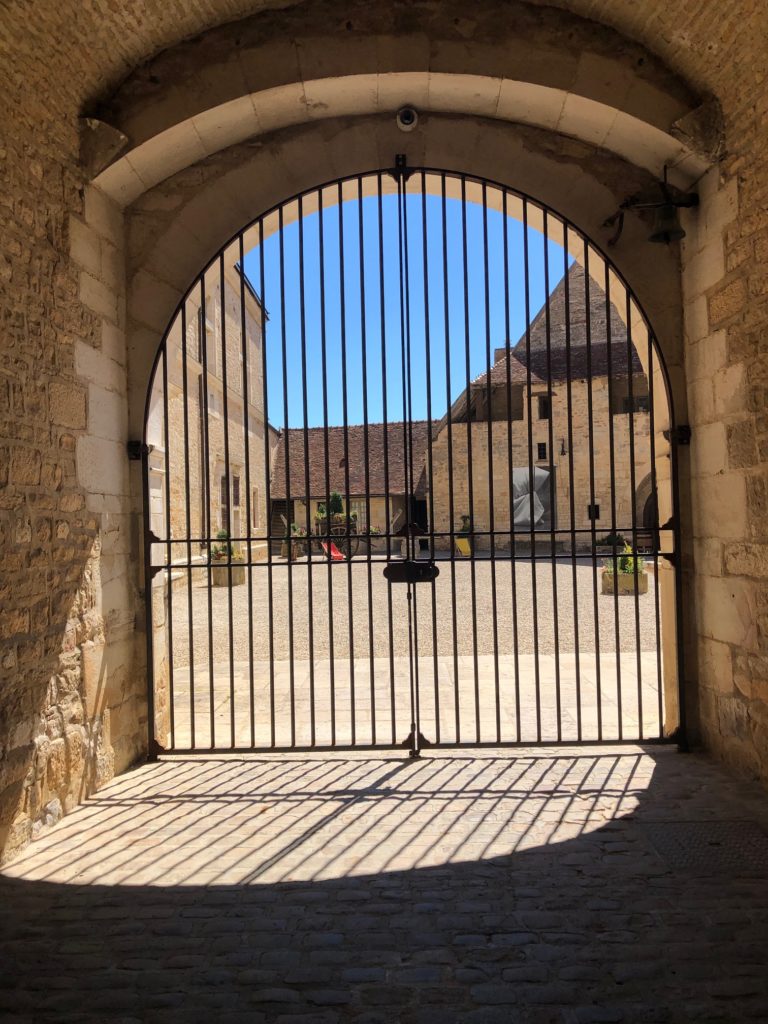
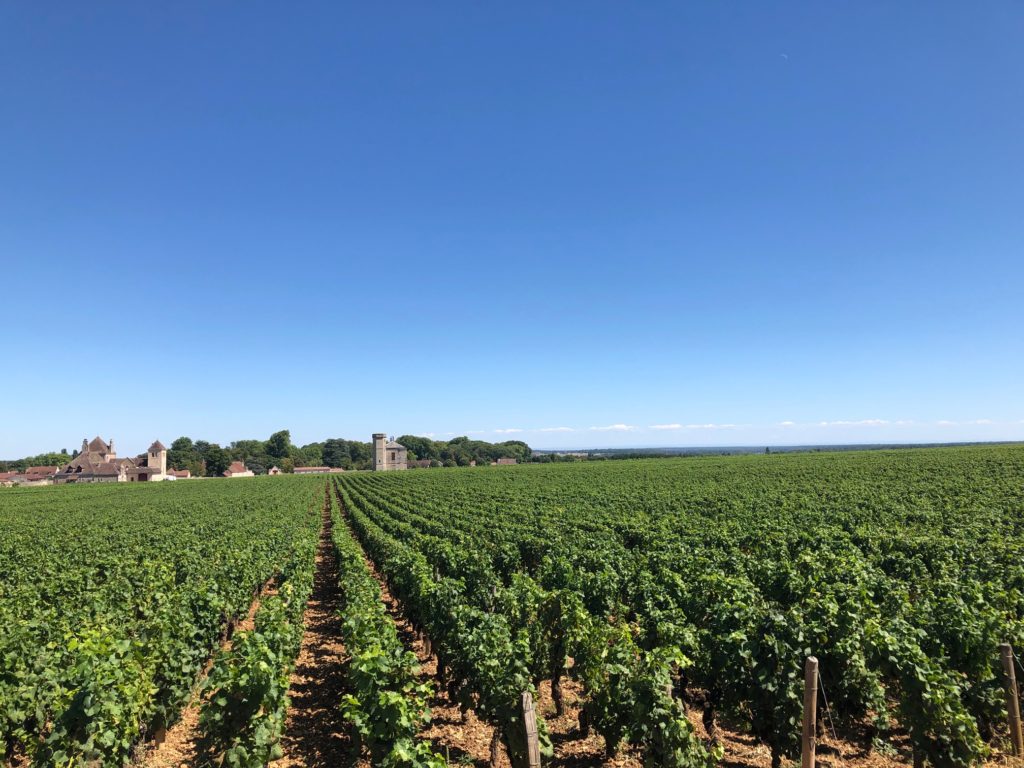
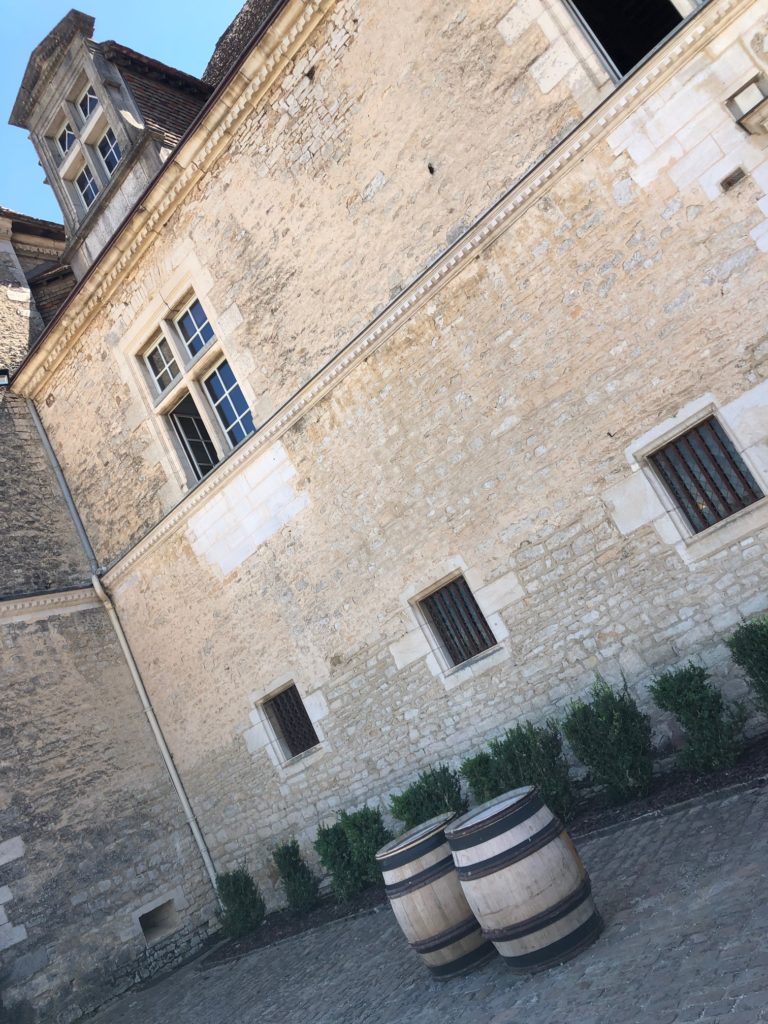
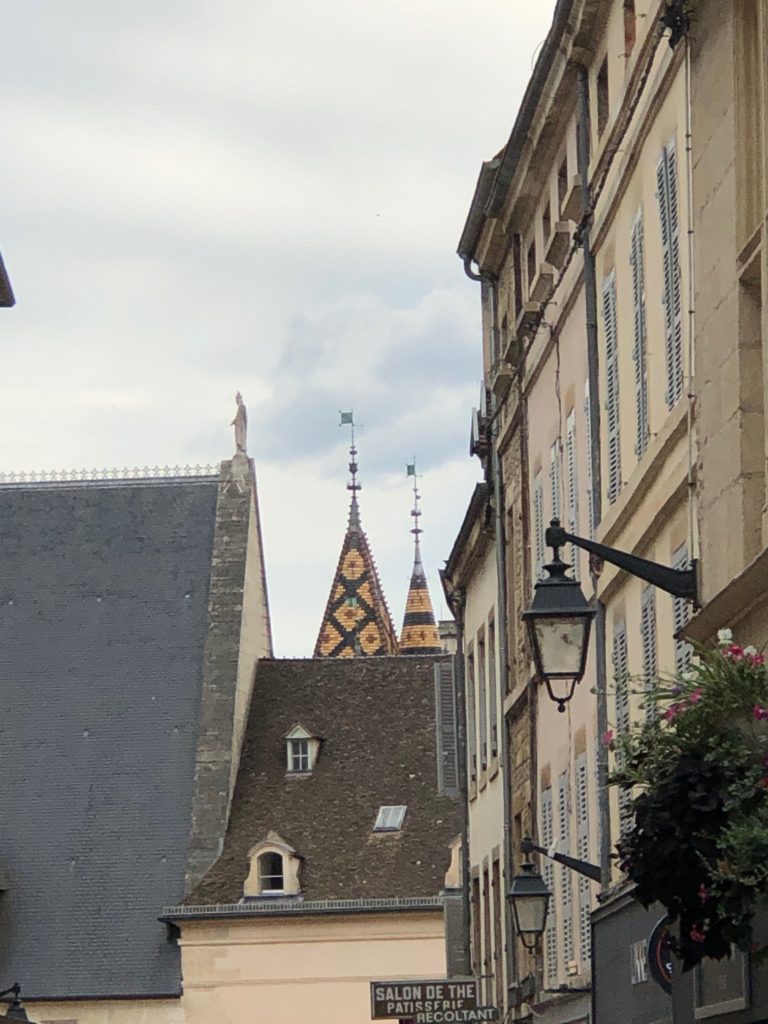
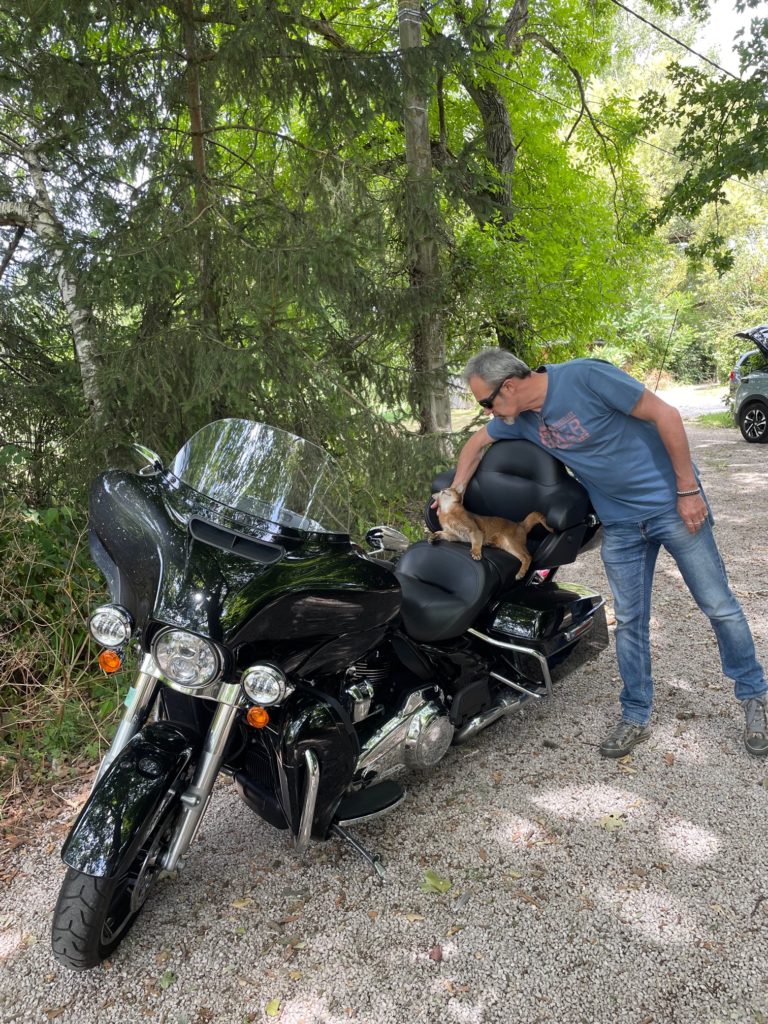




More Stories
RIDE TO LEONARDO DA VINCI’S CASTLE
RIDE TO BOOZ
RIDE TO THE VILLAGE CALLED HEDGEHOG